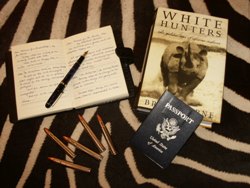

 The Accurate Reloading Forums
The Accurate Reloading Forums  THE ACCURATE RELOADING.COM FORUMS
THE ACCURATE RELOADING.COM FORUMS  Hunting
Hunting  Hunting Reports - Africa
Hunting Reports - Africa  2014 Selous Buffalo, Hippo & Lion Hunt
2014 Selous Buffalo, Hippo & Lion HuntGo  | New  | Find  | Notify  | Tools  | Reply  |  |
| One of Us |
Concerned about the future ability to import an African Lion, in 2012 I started planning for a trip for lion. My plan was to bring my sons along. Nick would be 18 and this would be his first dangerous game hunt. Justin, 20, would be along to run a camera. I invited another of my amigos, Ron, to join us as well. Ron planned to focus on Leopard while I focused on Lion. Planning & Booking with Adam Clements I knew I wanted to hunt with Mike Fell. Mike hunts in Tanzania with Adam Clements Safari Trackers. I was introduced to Adam by phone sometime in 2013 and we discussed my plans. Adam hunts several areas in Tanzania, but suggested the MHJ3 block in the Selous given my budget. Up until two years ago, this block was used exclusively by the King of Spain, who hunted Elephant in it. Because he did not hunt much plainsgame, the quality of the plainsgame, particularly Livingstone Eland and Kudu, is quite high. Leopards are abundant, but not particularly large. Although Lion mane quality is generally not as good in this area as it is in other areas, it’s less expensive to hunt this block, and given that I would be paying for three people plus a cameraman, it made sense for me. Moreover, Ron could hunt Leopard with us from the same camp. Two cat hunters focused on different species meant twice as much bait over twice as big an area. Adam made me no promises or predictions of success. He told me that mature Lions were there, but they weren’t abundant and that it could be a challenge to get one on bait. I accepted that and booked the hunt for late July/early August 2014. Although Adam said this wasn’t the optimal time to hunt Lions – he said later in the season would be better – the boys returned to school in late August, so this was about as late in the season as I could do it. Sadly, as we prepared to leave for the hunt my mother-in-law passed away. Adam was great about my situation. I assumed I would simply forfeit the money I had paid. But Adam offered to let me re-schedule the hunt for later in the season. Mike Fell would be available to hunt in late October/early November if I wanted to go then. Of course, the boys would be unable to join me, but as it turned out, this was probably for the best. Ron decided not to postpone and went in July as originally planned. Ron took a nice Leopard on his hunt and we got a good report from him after he returned. I invited another of my amigos, David, to join me in place of my kids. Although Dave felt bad about benefiting from my unfortunate situation, it was much better to have him along than to go by myself. Dave planned to focus on Leopard while I concentrated on Lion. We planned to hunt together for the first part of the hunt until we started getting cats on bait, at which point we planned to split. Adam set us up with a second PH, Dylan Cloete, to hunt with Dave once we split. We understood that Dave would be hunting on my license as a “companion” hunter, and that he could shoot anything from my license, including a Leopard, for the trophy fee. We agreed to pay $450 per day for a “bait car,” which could check and hang bait while we were hunting. The $450 covered the cost of the vehicle, fuel and staff for a whole second car. We asked about a second PH in the event we got a cat on bait and one hunter wanted to sit while the other hunted (or in case we had two cats feeding at the same time). Adam charged us another $250 a day for the second PH. Travel to the Selous We booked our travel directly with Delta through Amsterdam to Dar es Salaam. While it was a hassle to get set up, it went smoothly in execution. You need a permit from the Netherlands just to transit the airport in Amsterdam with a rifle. These permits aren’t issued until just before you travel, and we’d heard stories of hunters who got their permits only days before they were scheduled to depart, and in one instance, not until after their scheduled date of departure. You have to fill out a special form KLM requires for carrying firearms. And you need to have it noted on your reservation with Delta. We ticked all those boxes but no one ever asked us for KLM form and the only time we were asked for the Dutch in-transit permit was at the KLM check-in desk in Dar es Salaam on the return trip. The travel was long but uneventful. We arrived at about 10:30 at night in Dar es Salaam and were greeted by Sergio, Adam Clements’ man on the ground there. Sergio got us through the gun registration process and put us in a car to the Sea Cliff hotel, about 30 minutes from the airport. The Sea Cliff is old but nice. We were tired and immediately headed to our rooms to hit the rack.  The next morning we met our cameraman, Doug King, who formerly worked for Safari Classics filming for Tracks Across Africa and other Safari Classics productions. I met Doug the previous year when I hunted with Chifuti in Zimbabwe. Doug did an awesome job with the footage from that hunt and I asked him to come along with me to Tanzania. It wound up being two jobs for Doug, as he filmed Ron’s hunt in July/August and then returned to film my and Dave’s hunt in October/November. Mike Fell joined us for breakfast at the hotel and we then moved our pile of bags and gun cases back to the airport for the charter. I brought two SCI Foundation Blue Bags and hoped to make a donation in a nearby village. Unfortunately, we were overweight for the charter and were forced to leave one of the Blue Bags behind, though it came in later in the hunt when another hunter joined us in camp for a few days. As it turned out, we were working so hard on this hunt that I never had the chance to make the donation in person, though I left the contents of the bags behind when I left, with the understanding that the camp staff would make the donation. I was pretty disappointed about this, as I had previously donated Blue Bags in Zambia and found it to be a very rewarding experience, and Ron had donated Blue Bags during his hunt in July & August and similarly reported that it was a highlight of his hunt. The charter took about an hour and a half. We met Dylan Cloete at the airport in Dar for the charter. Dylan was recovering from a bout of malaria and looked like death warmed over. Fortunately, Dave and I planned to hunt together with Mike for the first part of the hunt, so Dylan was able to recuperate for a few days. 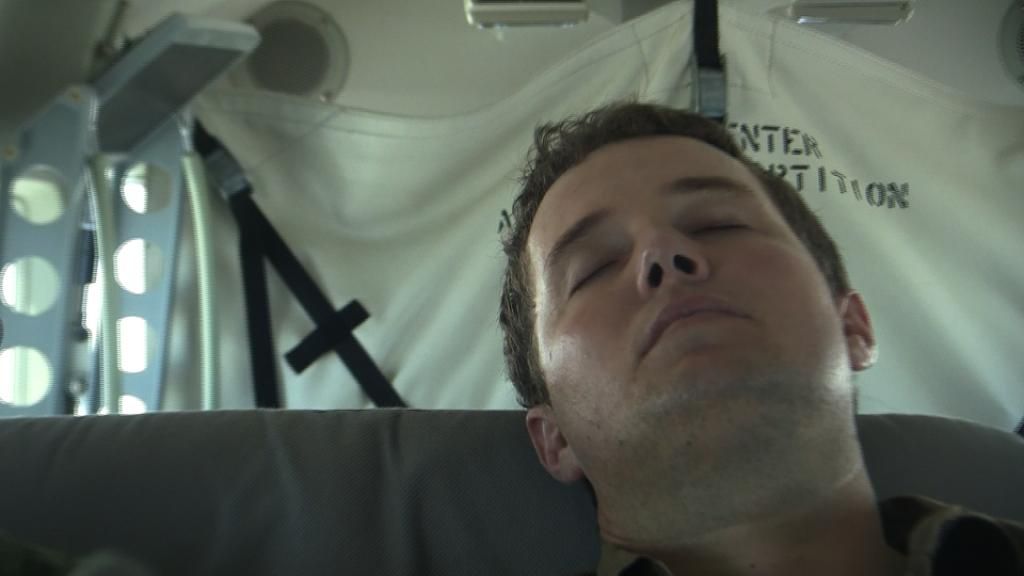 Accommodations The main camp in this block is typical for a hunt of this type. There are four Botswana-style tents with flush toilets, showers, etc. My tent had a double bed, Dave’s had two twin beds. Dylan and Doug shared a tent and Mike took the fourth. Meals are served in a double size dining tent. 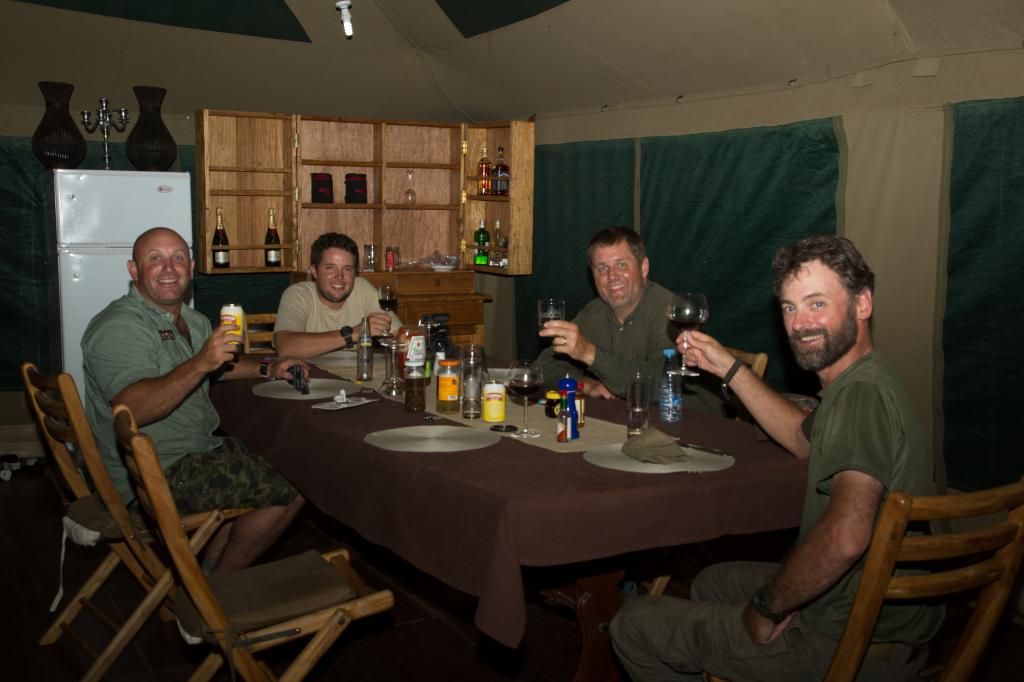 While my review of this hunt is generally very positive, there were a few negatives. The most important negative is the location of the main camp in relation to the hunting area. The area is quite large, but most of the good hunting is found about 2½ hours from the main camp.  We did kill buffalo near the main camp, but virtually everything else was found in a different area. We knew from the report we received from Ron that we would be spending some time in a fly camp in order to be closer to the area where most of the game is found. I believe I spent four or five nights of a 16 day hunt in the main camp. We spent two nights in an established fly camp. The fly camp was comfortable; we were provided with camping tents with foam mattresses and pillows. There was a latrine with a toilet over it and a bucket shower system. We had a table for meals and folding chairs.  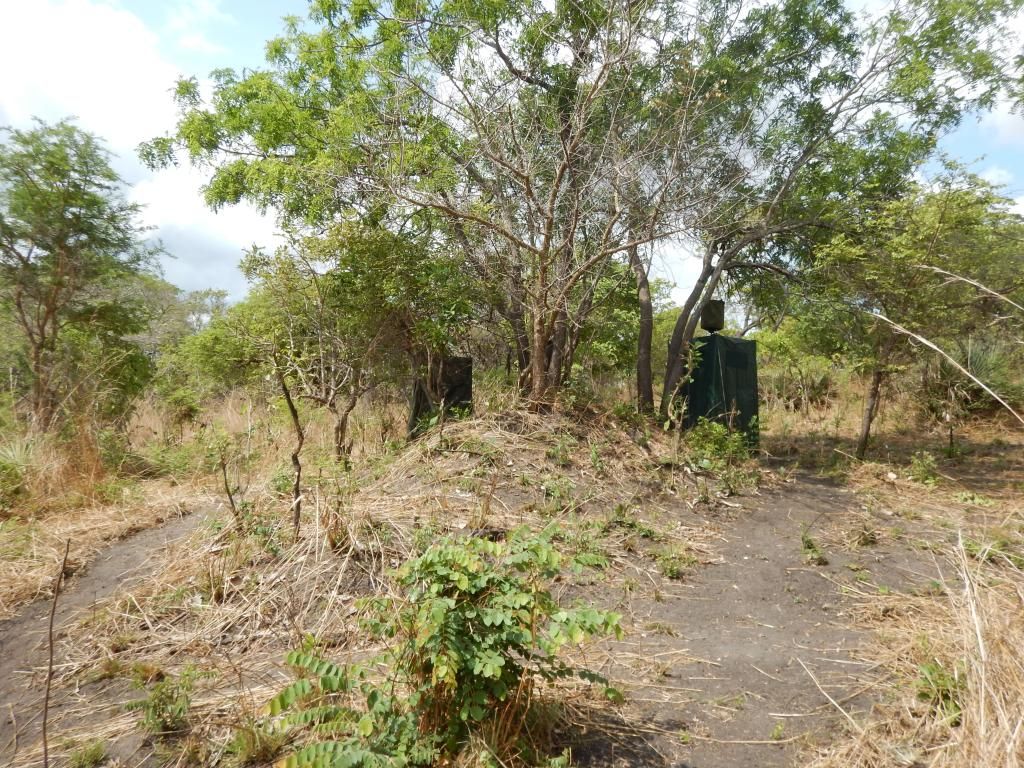 After the first week or so, Mike told me that our chances for Lion would be much improved if we slept out under the stars in the area where we thought a mature lion was located. Once we found tracks or had a picture of a mature lion on one of the trail cameras, we’d want to try to pinpoint his location by listening for him at night, and minimize the amount of travel time into and out of that area. 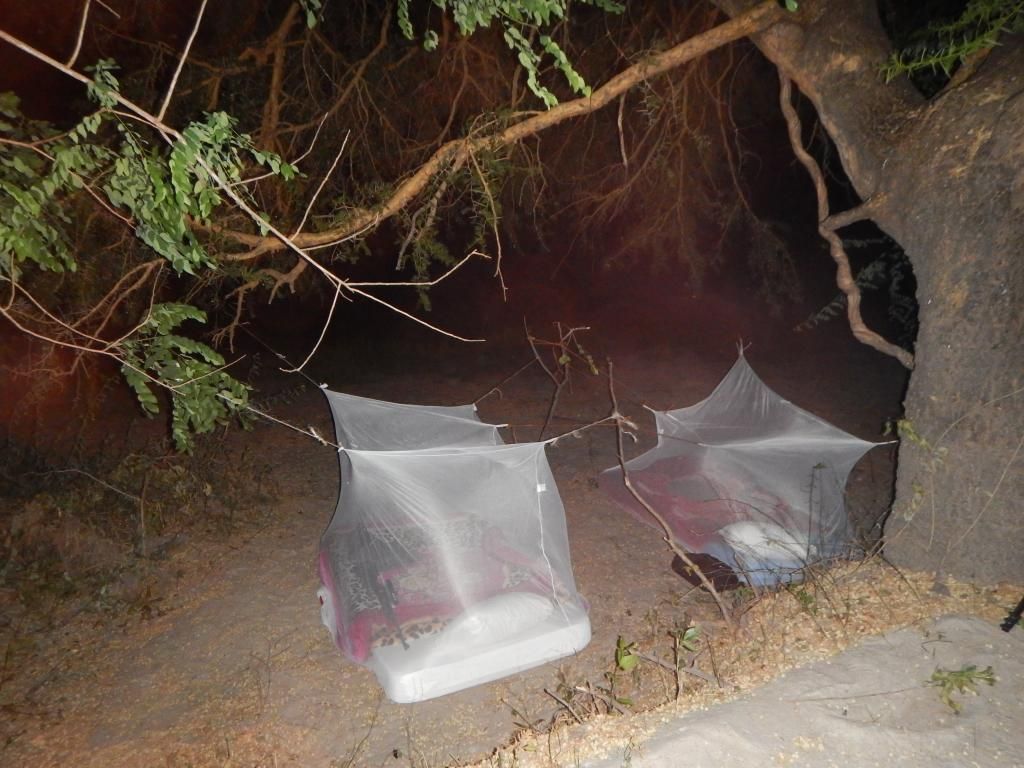 Sleeping under the stars was a pretty cool experience. The guys put the foam mattresses down on the ground and hung mosquito nets, so it was fairly comfortable notwithstanding the need to brush ants out of your nose during the night (fortunately, not the biting kind). Although it’s a little disconcerting at first to try to sleep while listening to hyenas whoop and lions roar and hippos grunt with nothing between you and them but a mosquito net, the fact is that a tent doesn’t provide any security against anything that might be interested in you in the night. The only thing that really made me nervous was the fact that Doug and Mike both snored loudly every night, and if I were a lion or a hyena and heard that sound I’d probably want to check it out. The Roads The roads in the area are in poor condition. While the vehicles were in good shape, it was a challenge to keep them in that condition. We broke both trucks at some point during the hunt. 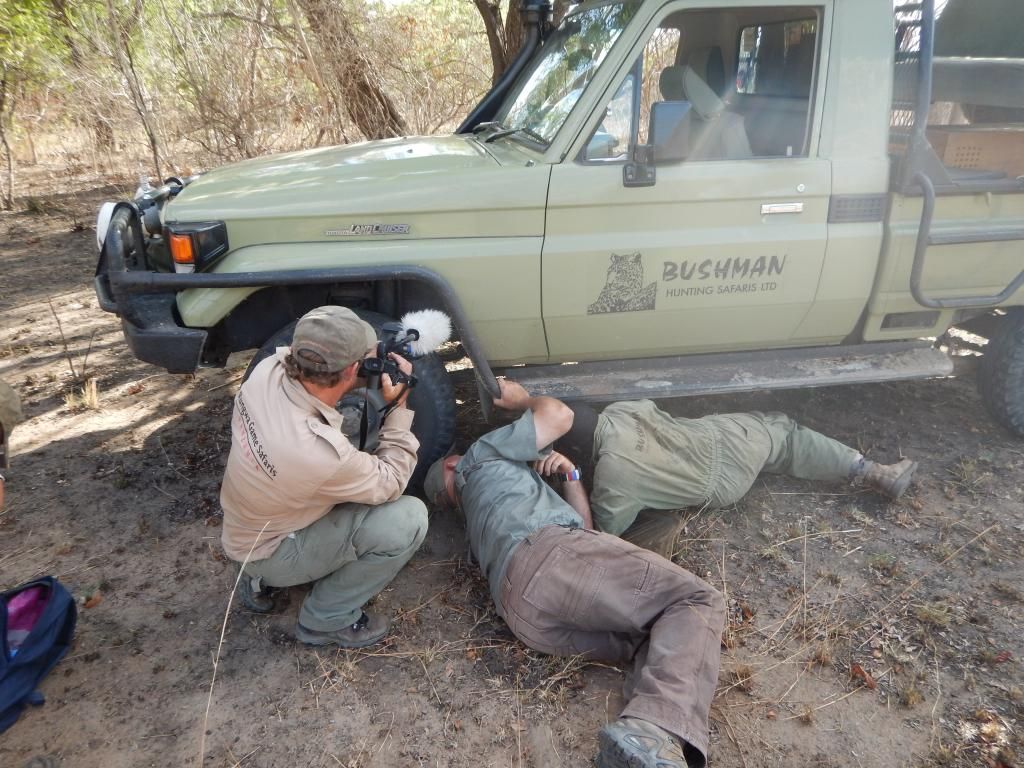 When Fell’s vehicle needed to be taken to the local village for a weld, I hunted with Dave and Dylan from Dylan’s vehicle, which broke two leaf springs. There is a lot of soft sand in the area, and getting stuck and having to winch or dig out was a frequent occurrence. 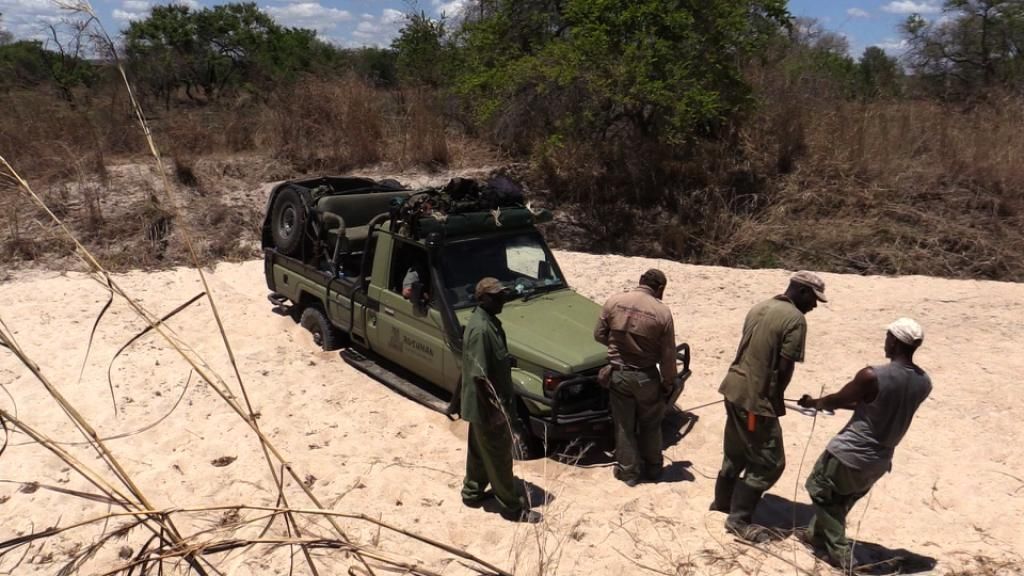 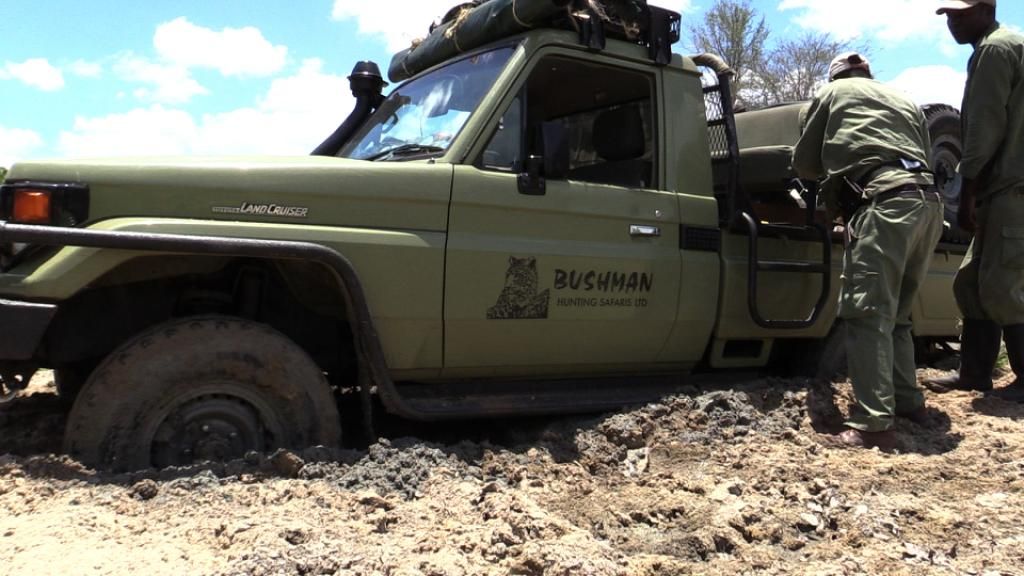 When Dave and I were there in early November, the “short rains” had started. Fortunately, we saw rain on only a few days and even then the rains were indeed “short.” Had there been any significant rain, I’m sure those roads would have been impassable. The Food The food on this hunt wasn’t great, particularly the lunches. The wooden lunchboxes had seen better days; in fact, ours fell apart one night during dinner while we were using it as a makeshift table; it dumped our meager dinner all over the ground. 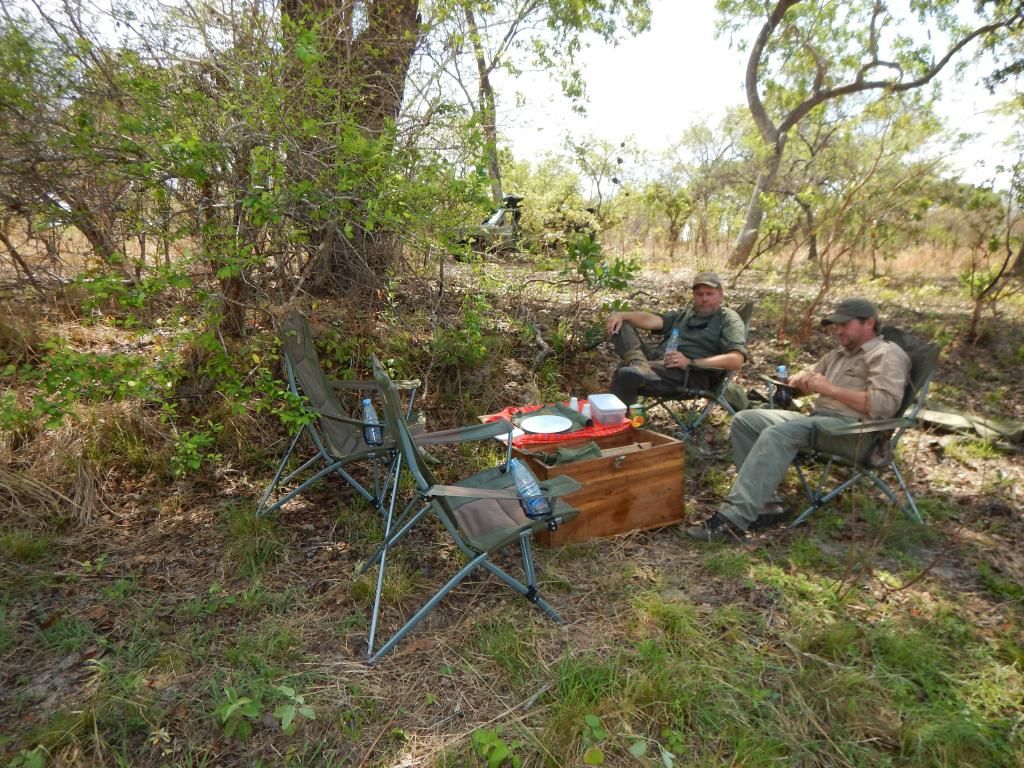 A couple of times lunch consisted of little more than a scrawny chicken leg and cans of inedible Bully Beef, though there were always canned peaches or other fruit available. Coffee in the morning was generally not available when we were sleeping out – at least, not until we took a morning break after having been up for three or four hours. This seems like a petty gripe, but not having a simple cup of coffee in the morning got old real fast. When we did have a minute or two for a coffee, it was made by placing water bottles directly in the embers of the fire – believe it or not, the plastic doesn’t melt and the water boils inside. 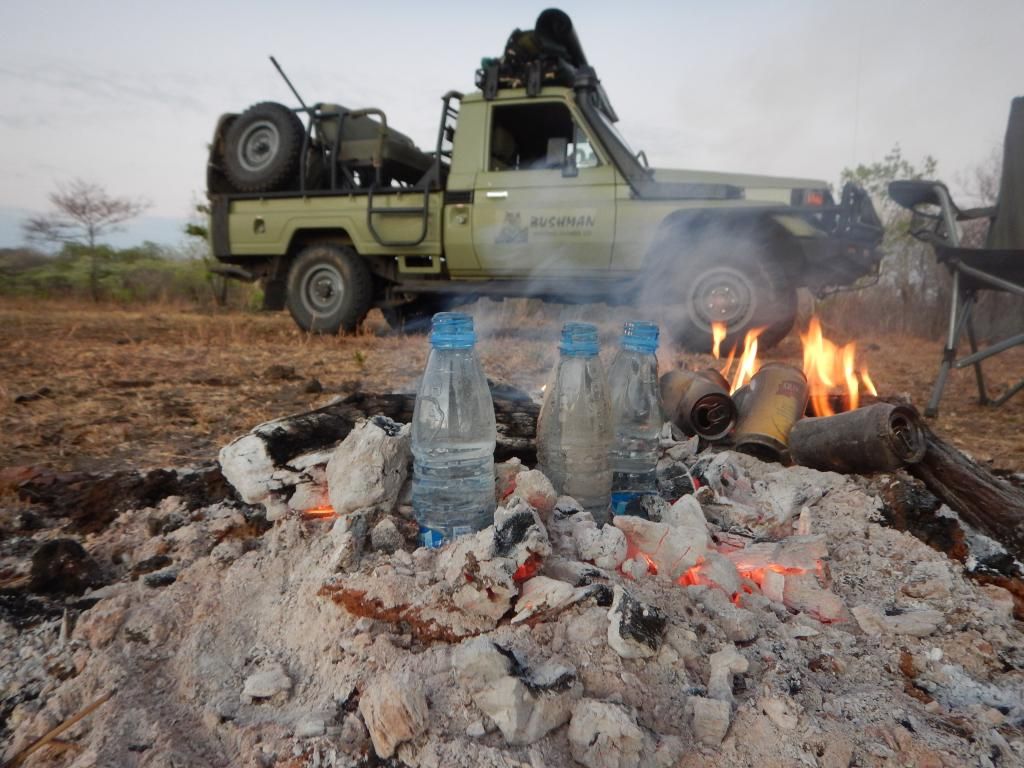 No kettle or other means of boiling water was provided in the lunchbox. The plastic water bottle heating method worked, but can’t have been very good for my health. Still, I was willing to trade a few months off my life for a cup of coffee most days. The best meals were the ones the trackers cooked for us over an open fire when we slept out. Those guys could make a tasty sauce from just about anything, and would cook whatever it was we had killed that day along with sadza. I enjoyed that food more than the meals prepared for us in main camp.   Rifles & Ammunition For this hunt I elected to try a Blaser R8 for the first time. I took advantage of a deal Eurooptic offered at the DSC show in January of 2014 and bought a system that included a .300 Win Mag barrel and a .375 H&H barrel, with Zeiss scopes with the integrated rail mount and the illumination control that turns the illumination on when the rifle is cocked and turns it off when it is decocked. The deal included a free .204 Ruger barrel with the purchase of two barrels. I had a few frustrations dealing with Eurooptic. For starters, they did not have the scope mounts I needed in stock. After several months of waiting and facing an upcoming trip to SAAM for training, I Googled the mounts and found them available on eBay for approximately $50 more each than Eurooptic was charging. So I bought them on eBay. When they arrived, the return address on the packaging was the same as the Eurooptic address but with a different company name. I called Eurooptic to cancel the ones I had ordered at DSC and to demand an explanation for why they told me mounts were out of stock when I bought them from apparently the same company on eBay. The guy I talked to on the phone had no answers. Also, I still don’t have my .204 Ruger barrel, one year later, and no communication from Eurooptic. If I don’t call them, they certainly don’t communicate with me about the status of my order. Generally I’m impressed with the Blaser, even though it violates one of my rules for gear you take into remote areas. Generally I prefer my gear to be as simple as possible. The Blaser is anything but simple – it’s full of little bits and pieces. But I can’t argue with a system that works, and I must admit that the Blaser works, with one exception. For reasons I can’t explain, with the .375 barrel installed and no scope mounted, mine will decock after firing approximately 10% of the time. It only happens when the scope is off. When the scope is mounted, it never does this. Obviously, this is dangerous. I would only have the scope off if I were following up something wounded and dangerous. It is absolutely essential that the rifle fire every time I ask it to, without having to stop to think about whether it’s cocked or not. Once I cock the rifle I want it to stay cocked after I cycle the bolt for the next shot. It’s very disconcerting to cycle the bolt, pull the trigger and get nothing because it decided to decock itself. Mike Fell is a Blaser fan and carries an R8 with a .375 barrel and an Aimpoint sight for backing up clients on plainsgame (Mike also uses a .460 Weatherby to back up clients as well as a .577 Greener double when following up wounded dangerous game). It was Mike’s opinion that the issue I was having with the Blaser was connected to the illumination control system somehow. I’m still working this issue out, but meanwhile I don’t trust the Blaser with the scope off and would either follow up dangerous game with the scope still attached (it goes down to 1.1x) or would swap the Blaser for my double before following up. I sent the Blaser and scopes to my buddy Dave (who ultimately wound up joining me on the hunt) to make a custom cut Pelican case for the rifle. Dave’s company, Deployable Systems (www.dscases.com), provides custom hard cases for all manner of gear. He is primarily a government contractor but also makes cases for civilians. His case for the Blaser is a work of art. 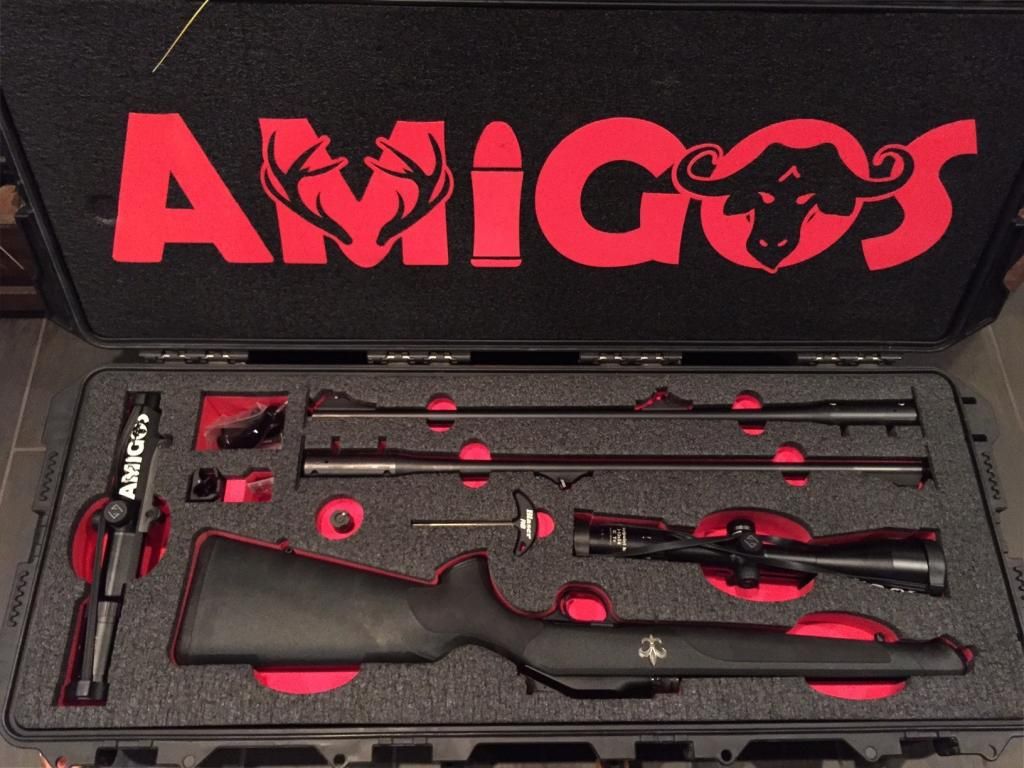 I load my own ammo. For this trip I elected to shoot Nosler Partitions from the .300 Win Mag and the .375 H&H. For the .300 Win Mag, I loaded 180 grain Partitions over 80 grains of H1000. My chrono showed I was getting an average of 2,900 fps from that load. I took 40 of these rounds with me to Tanzania. As it turns out, I never fired a single round of .300 Win Mag, a lesson I’ve learned on previous safaris on which I’ve brought smaller caliber along with a .375 and never touched the smaller caliber rifle. Next year when I hunt in Mozambique I’m only bringing the .375. And my double. For the .375 I loaded 300 grain Partitions over 79 grains of RL-19. The chrono showed I was getting an average of 2,381 fps from that load. I was unable to acquire Nosler solids for the .375 – there were none in stock anywhere. So I elected to load 300 grain North Fork Cup Point solids in .375 H&H over 78.5 grains of RL-19 for my backing shots. As indicated below, I was really impressed with this bullet. I also brought my Merkel double in .450-400. One of my goals was to take a Buffalo with the Merkel as well as possibly a Hippo. Nosler doesn’t make a .410 400 grain bullet, so I loaded 400 grain Hornady DGX bullets over 81 grains of H4831 for my softs and 400 grain North Fork Cup Point solids over 81 grains of H4831 for my solids. The chrono showed I was getting between 1,975 and 2,050 fps from these loads (the North Forks went about 25-50 fps faster than the Hornadys with the same load). The Merkel strikes low when I line up the sights instinctively. For reasons I don’t understand, Merkel designs its sights so that you are supposed to hold with the front bead level with the TOP of the rear sight, rather than burying the bead in the notch, the way I learned to shoot open sights and the way I naturally do it when not thinking about it. So I sent the Merkel to New England Custom Guns to have the front sight replaced with a lower (and adjustable) sight. To this day I’m working with the Merkel to find the right front sight height and load combination to get that rifle to strike at the correct elevation using my preferred and natural hold. The Merkel is also still incredibly tight even though I’ve had it for two years now and put somewhere between 500 and 750 rounds through it. 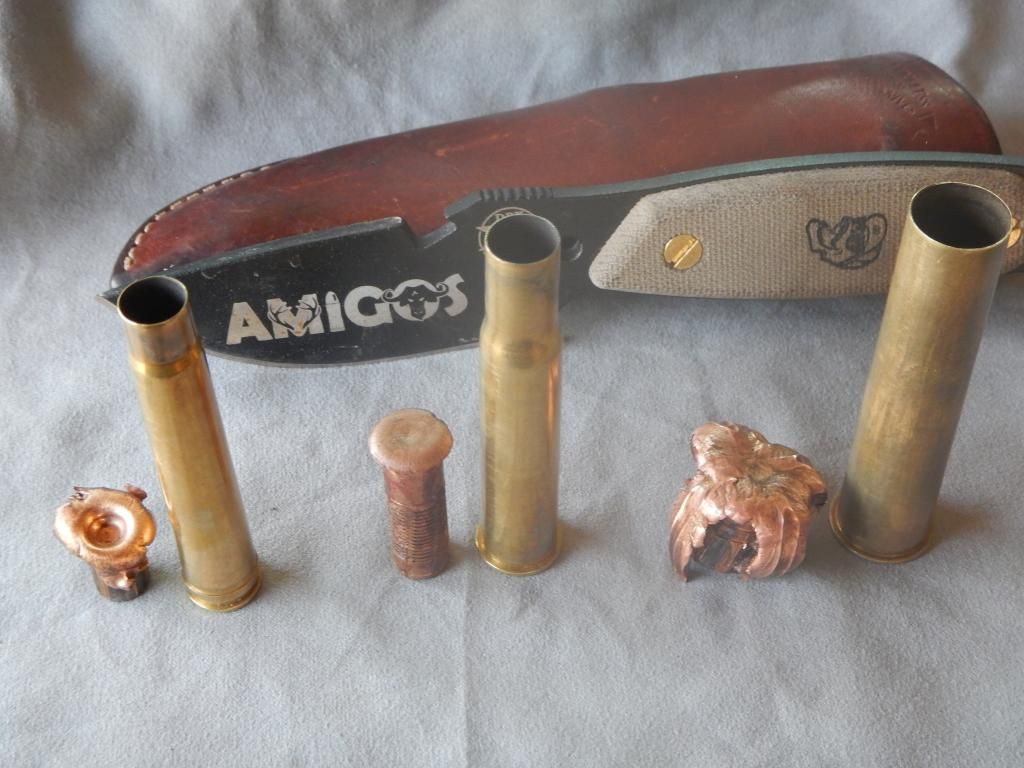 Preparation – SAAM In May of 2014, the Amigos group attended SAAM shooting school in Barksdale, Texas. Over three days we went through a modified curriculum that included aspects of both the precision rifle course as well as the safari course. I can’t say enough about what Tim Fallon, Dog, Larry, and the staff at SAAM do for hunters. I felt like I learned a ton and got a lot of great feedback from those guys, and I’m anxious to return for more. It was impressive to see how far you can shoot if you know the dope for your rifle and ammunition and someone gives you an accurate wind call. And the practice shooting moving targets during the safari course is something that many of us simply can’t get anywhere else. My shooting on the Tanzania safari was much better than it’s been on past safaris. With few exceptions the animals I shot were hit very well and required no follow up. All three bullets (Nosler Partitions, Hornady DGX, and North Fork Cup Point Solids) worked as advertised. We had no major tracking projects; the worst was following the third Buffalo I shot, who started to turn just as I committed to a frontal shot, putting my bullet just off the center of his chest. I hit him a second time in the rear as he departed. As described below, that entailed about a mile and a half of tracking, after which Mike and I were able to each put another shot into him and put him down. I don’t know how anything can remain standing after being hit just about anywhere with a 750 grain jagged, spinning chunk of copper flying out of Mike’s .577. I had some long shots (I did miss a hartebeest at 285 yards, but only because I misjudged the distance and shot under him). In addition to the SAAM training, I fired hundreds of rounds from each rifle at the range throughout the spring and summer, shooting mainly at 50 yards from the sticks and frequently at lion and buffalo targets I got from Safari Press. Baiting\PlainsGame Hunts Mike Fell is a big believer in hanging a lot of bait to locate a lion that merits building a blind and sitting. He doesn’t have a lot of patience, and doesn’t want to invest the time sitting still in a blind unless he’s pretty convinced that the lion will come to the bait during the day and that it’s a lion he wants to shoot. The first part of our hunt was devoted to shooting a lot of bait and getting it up. We ultimately hung over 30 baits total (not all at the same time, though we had nearly 20 baits up simultaneously). 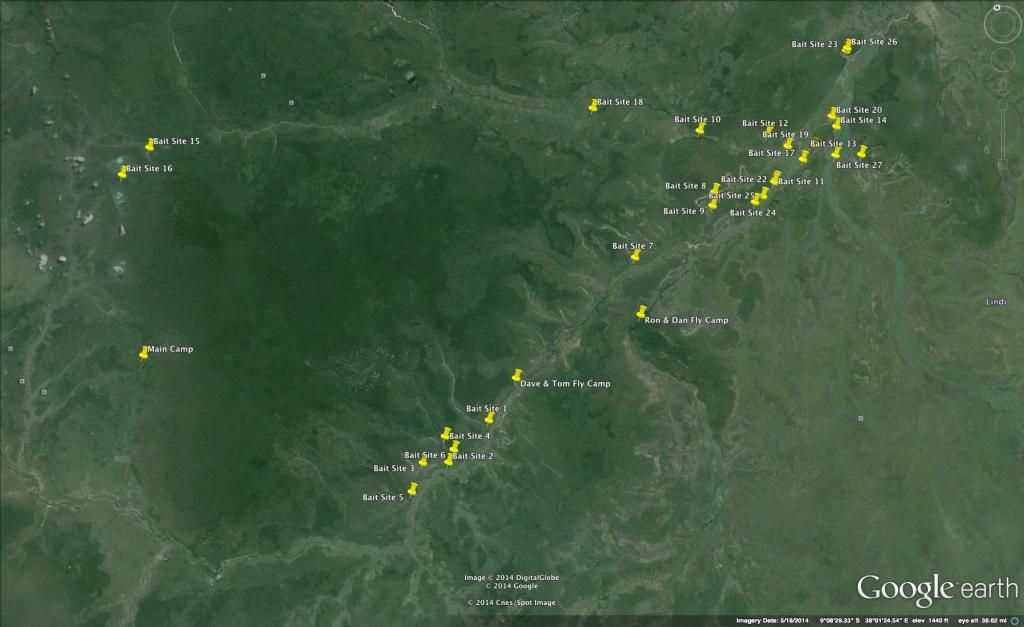   I knew we would be shooting a lot of plainsgame that I might not otherwise have had much interest in just to ensure we had sufficient bait up, but I did not anticipate the pressure we would be under to keep the baits fresh right until the very last day of the safari. 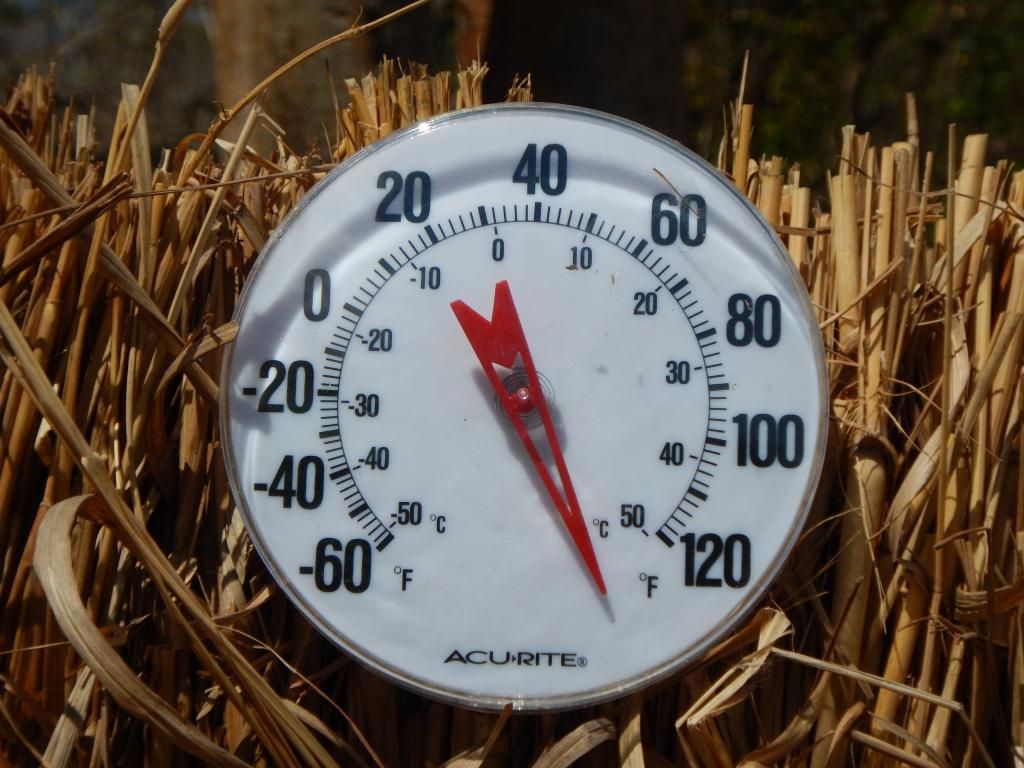 The heat was a problem. Baits rotted quickly in the 100 degree plus daily heat. We didn’t get much relief at night – temps stayed up in the 80-90 degree range for most of the night, though we did get a nice breeze between about 7:00 p.m. and 11:00 p.m. each evening. Some baits only lasted two days. The best we got out of our baits were the Hippo and Buffalo baits, which generally lasted four, maybe five days. The worst was a Waterbuck we only got a single night out of – by the morning after the second night it was hung it was useless. There is an abundance of plainsgame in this block, particularly Lichtenstein’s Hartebeeste, Impala, and Waterbuck. The Impala were dinks; in 16 days we saw dozens of Impala every day but only one ram I would have even considered shooting. Impala was just about the only thing Mike didn’t ask me to shoot, mainly because I had no interest (I have several in my trophy room already and, as I said, these were dinks) and they were too small to make useful lion bait. The Hartebeeste and Waterbuck were both of good quality however. I shot two decent Hartebeeste as well as a very nice Common Waterbuck. 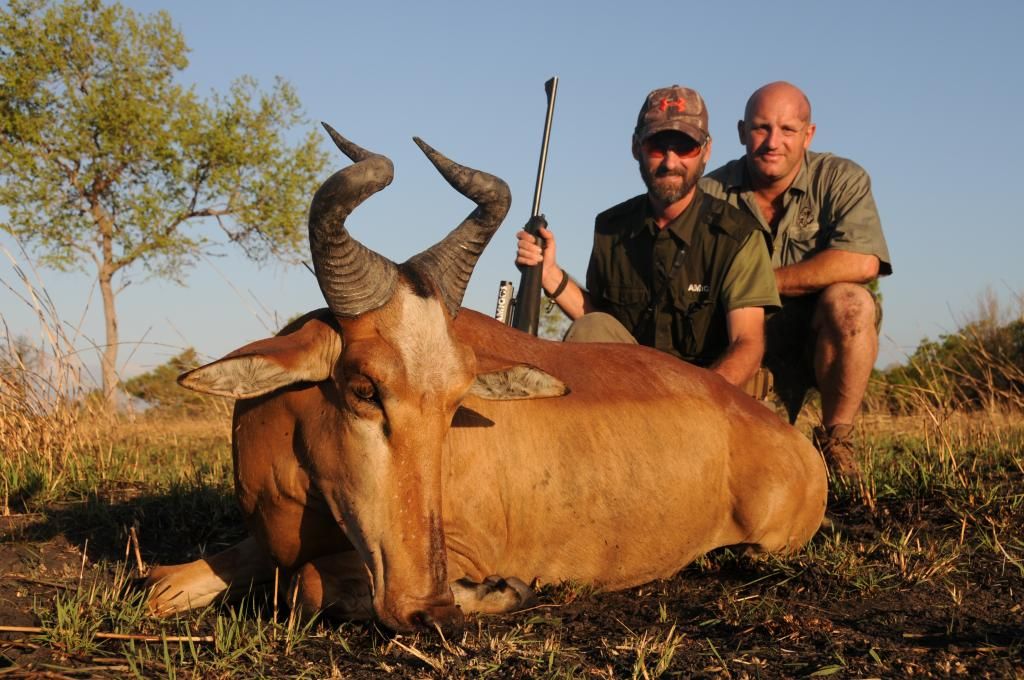 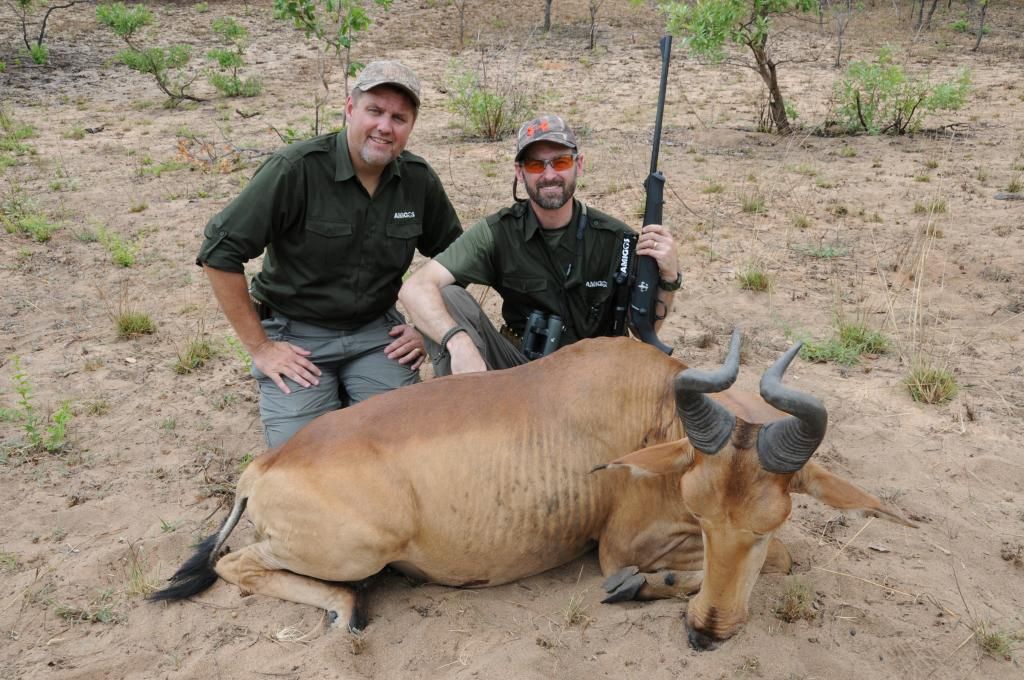 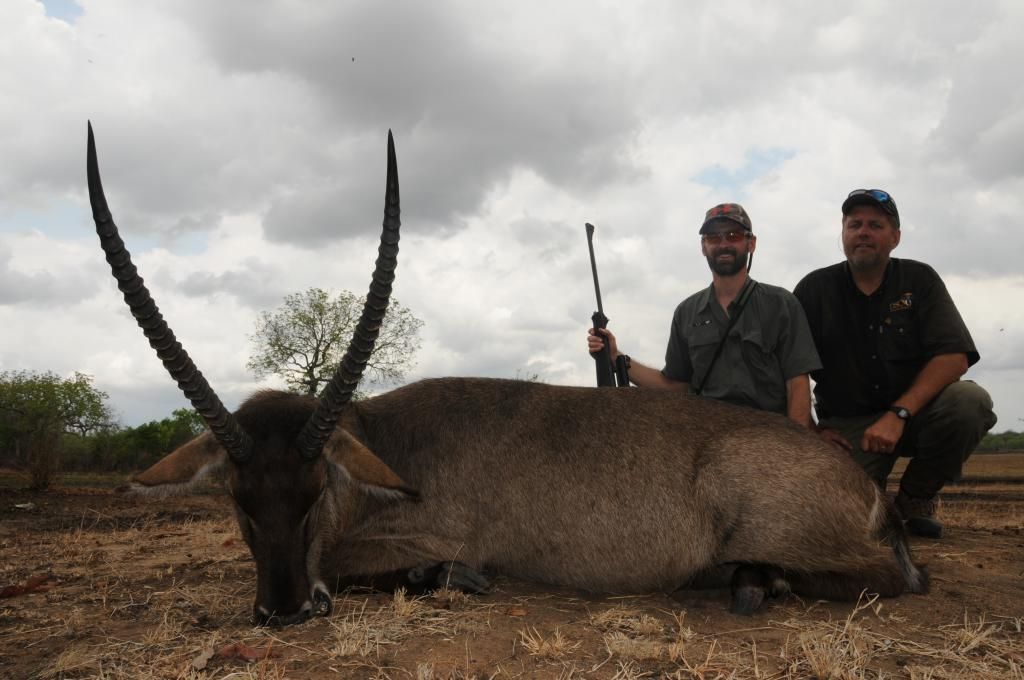 Mike and the trackers were much more excited about the Waterbuck than I was. This was one of only two animals we put a tape on during this entire hunt – he was just under 30” but still the biggest one shot in this block since Adam Clements acquired it, according to Mike. Dave also shot a Hartebeeste. After the Hartebeeste, Impala and Waterbuck, Zebra are probably the next most prolific species of plainsgame we saw. We saw them nearly every day, but they were a little “spookier” than the other game. Still, Dave and I had no trouble taking one each within the first couple of days of the hunt. Zebras make good lion bait. The hide on the subspecies of Zebra they have in the Selous is very beautiful, striped all the way to the hoof with no shadow striping. 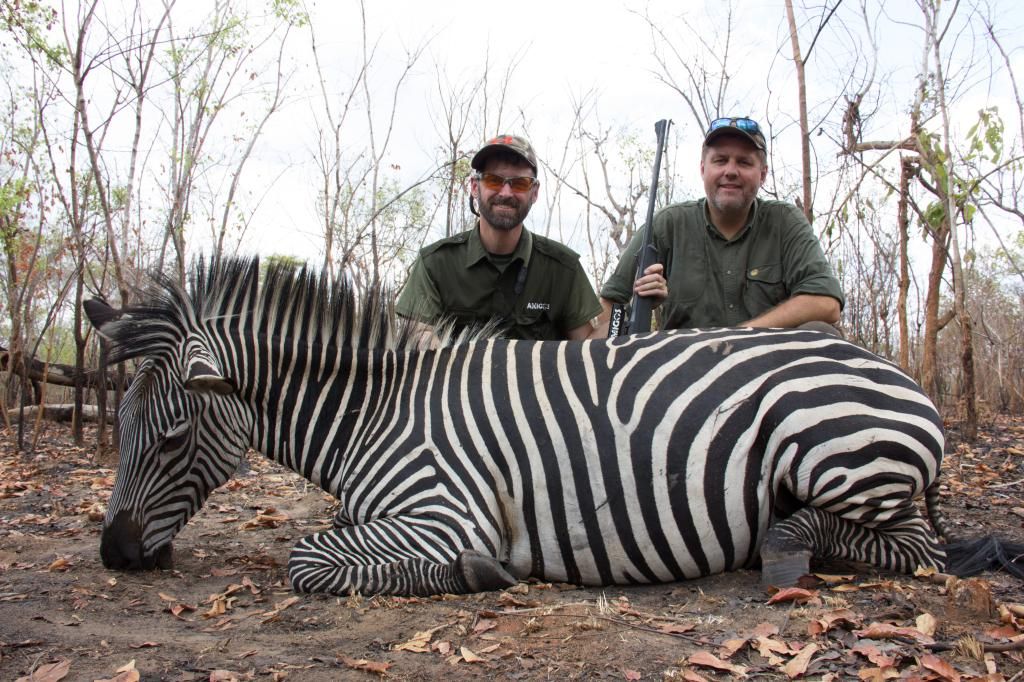 The area has a good reputation for Livingstone’s Eland, and Dave took a dandy about halfway through the hunt. I was simply unlucky with the Eland. I desperately wanted one like Dave’s, but we just weren’t seeing them. We came across two bulls one day that stood nicely for me at about 150 yards, but Mike deemed them both too young and we let them walk. Later we got on the tracks of a herd and followed them to the border of the concession before turning around and walking miles back to the vehicle. We had a third opportunity when we spotted herd with a very old, very dark bull in it in the thick Miombo forest. We got on the sticks and started sorting them out when they either caught our wind or heard us or saw something they didn’t like and took off. We followed and bumped them a few times but never had a decent opportunity. Eventually we called it off as futile and got back to whatever it was we had been doing when we spotted them (almost certainly driving to check another bait). This block is also known for good Roosevelt Sable, and I was fortunate to take one on the first day of the hunt. Late in the afternoon while generally hunting back toward camp Mike spotted a small black spot in the trees – just a Sable butt several hundred yards off the road. But we jumped out and headed up a gentle slope through the trees. Our wind was good and the bull was by himself, without the benefit of the eyes and ears of others to detect our approach. Mike put up the sticks and whispered to me “I’ve given you a horrible shot, but can you see him?” I could see him OK, facing away from me at about 150 yards or so, but there were too many trees between me and him for a clear shot. “I can see him, but I have no shot,” I told Mike. “Here, let’s move, but don’t let him get away. This is a rare opportunity,” Mike whispered back. We moved about 10 yards to our right. I got on the sticks and looked at the ass end of the Sable, now quartering away from me, offering me his right shoulder and looking back over that shoulder at me. I didn’t hesitate and am proud to say I put the Partition exactly where it’s supposed to go in that situation. It was a tight shot but well-executed. The bull ran about 30 or 40 yards and went over. Mike and the trackers (and I) were elated. We didn’t measure him, but he’s a beautiful trophy. Although not the first Sable I’ve killed, this was the first one I’ve eaten, and I learned that Sable is actually pretty good. 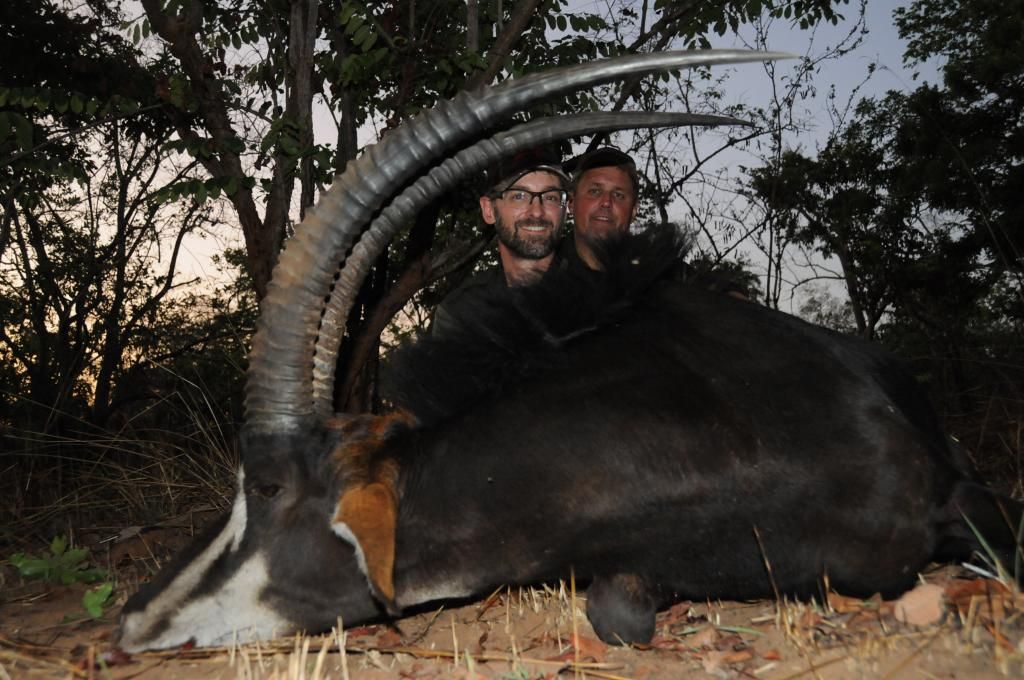 One afternoon our lead tracker spotted a Chobe Bushbuck and we wasted no time in getting set up for him. I couldn’t see his horns – his head and his hindquarters were both behind trees in the thick Miombo. But Mike assured me this was a nice trophy and that the reddish patch of hide I could see through the trees was the “sweet spot”. I center punched that spot and the Bushbuck didn’t take more than a step or two. 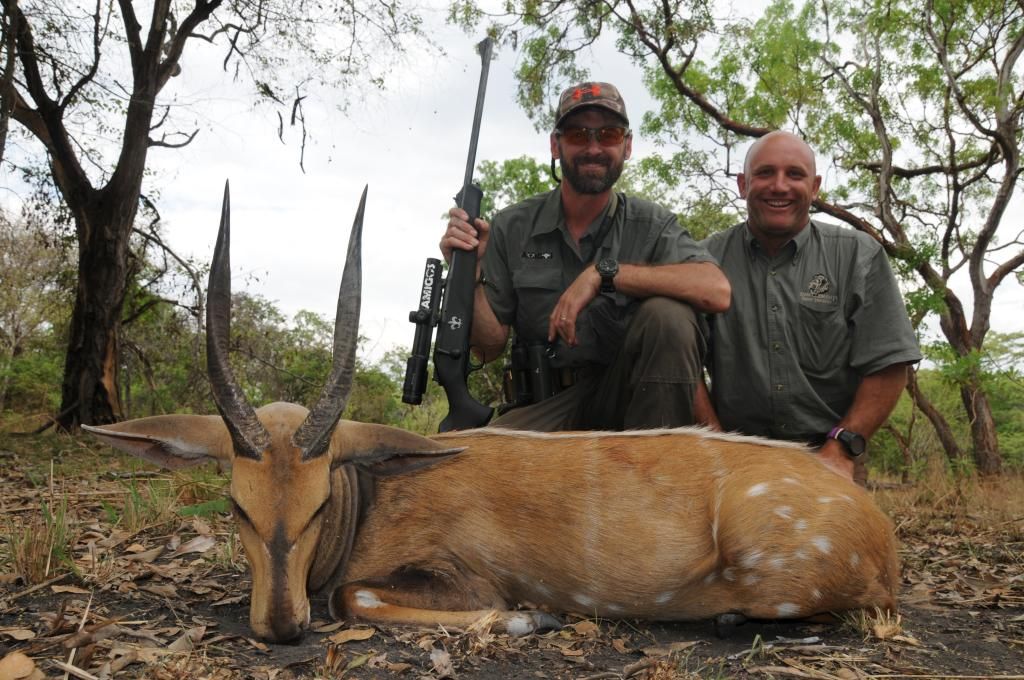 Another species endemic to this area is the Nyasa Wildebeeste. I shot two of them. 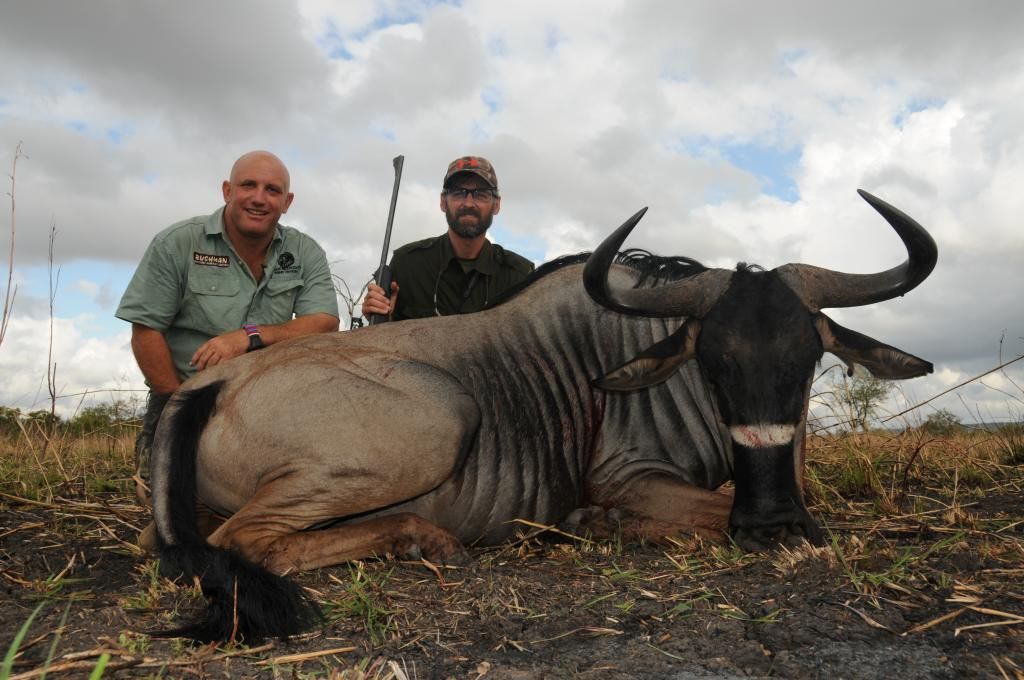 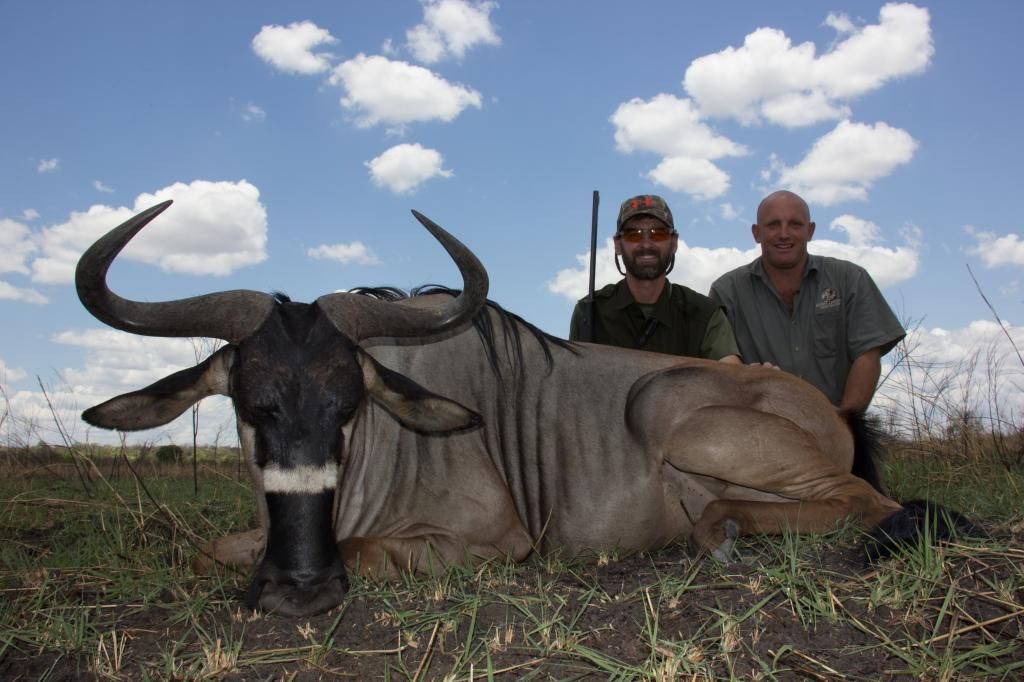 Hippos Dave and I were both eager to try Hippo hunting. We had seen video from Ron’s Hippo hunt in July, and it was a heart pumper. In the Selous, and particularly at this time of year, Hippos are hunted on dry land. There isn’t a lot of water around – at least, not enough for Hippos to spend the entire day submerged. There is one spot in the block that we called the “Hippo Pools” that held a large pod and was deep enough for them to remain submerged, but rather than setting up on the bank and sniping one in the water, we hunted them by spot and stalk. Early in the hunt Dave had spotted a Hippo concealed in a patch of muddy brush barely larger than the Hippo itself. There was a puddle of water under that patch of brush, and the Hippo was laying in it under the brush. There was a dark hole at one end of the brush, and we could see the Hippo’s butt in there, but we couldn’t see the head and Mike couldn’t tell whether it was a bull. So we posted up about 15 yards from the hole in the brush and the trackers commenced throwing rocks, sticks and clods of mud at the Hippo. “Be ready, because when he comes, he’s going to come like a bomb,” Mike said. “But don’t shoot unless I say, because it might not be a bull.” Despite scoring several direct hits on the Hippo’s butt, it refused to budge from its hidey hole for a long time. Eventually, though, the Hippo tired of being tagged with sticks and mud clods. It turned and in a great splashing blink of an eye came bailing out of the hole. “DON’T SHOOT, DON’T SHOOT, IT’S A COW!” Mike yelled at me. The Hippo turned away from us and trotted up a slope and away, stopping at one point to look back at us. That was intense. On the day Mike decided we would hunt my Hippo (Day 3 of a 16 day hunt) we simply walked quietly along the banks of the river and very cautiously poked through the thick brush, looking for Hippo laid up in the shade. At one point we took a break to pee or have a drink of water or something. Dave asked me if could see something in the corner of his eye that was bugging him. I looked and could see what looked like a speck of dirt there and told him so. “It’s not a tick, is it?” he asked. “F@%! Yeah it is!” I exclaimed as it dawned on me what I was looking at. “Well get it out of there!” Dave yelled at me. I tried picking at it but was making no progress. “Here, let me try,” Doug (the cameraman) offered. He handed me the video camera and tried several times to get the tick between his fingernails before finally succeeding and pulling up a giant tent of skin from the corner of Dave’s eye. Finally the tick cried “uncle” in this tug of war and let go. Dave put a small dab of hand sanitizer on his finger and cautiously rubbed it into the spot where the tick had staked his claim. As we climbed down the riverbank into the dry riverbed we were continuing to talk (loudly) and laugh about Dave’s battle with the tick. We had forgotten for the moment that we were hunting Hippos. Mike turned to us and “shushed” us. Not two minutes later we rounded a bend and came upon a giant bull Hippo lying in the sand, sound asleep. This Hippo was obviously an old warrior who had recently been evicted from his pod by a younger rival. He was covered with scars and open tusk wounds. He had found himself a shady spot in some very shallow water and was sleeping off his recent defeat, totally unaware of our presence despite the loud talking and laughing. Mike put the sticks up. I was carrying the double rifle and got on the sticks, but the angle only offered a shot at the top half of his body and none at his head. So I took the rifle out of the sticks and advanced to about 10 yards from him. When I could see his vitals clearly I put a North Fork Cup Point Solid into him. He immediately jumped and began to turn away from us. I hit him a second time on the shoulder. As I was breaking the gun to reload, Mike shouted at me “Hit him again! Hit him again!” “I can’t,” I yelled back, “I’m shooting a double!” But I dropped two more cartridges into my chambers and Mike and I scrambled up the bank to cut him off as he ran around a bend in the riverbed. As we came to the bank across the oxbow we saw him attempting to climb the opposite bank. Fortunately, his front leg or shoulder was broken and he was unable to climb – had he made that bank he would have gained the tall grass on that side of the river, and the follow up would have been a lot more interesting. I whacked him two more times on that bank, broke the gun again (no one ever seems to mention how hot a double gets after you fire four shots and have to break the rifle with your bare hands), and dropped two more in. The Hippo had now rolled over on his back and literally had all four legs in the air and I put two more right in the center of his chest. And that was it; he didn’t move again. 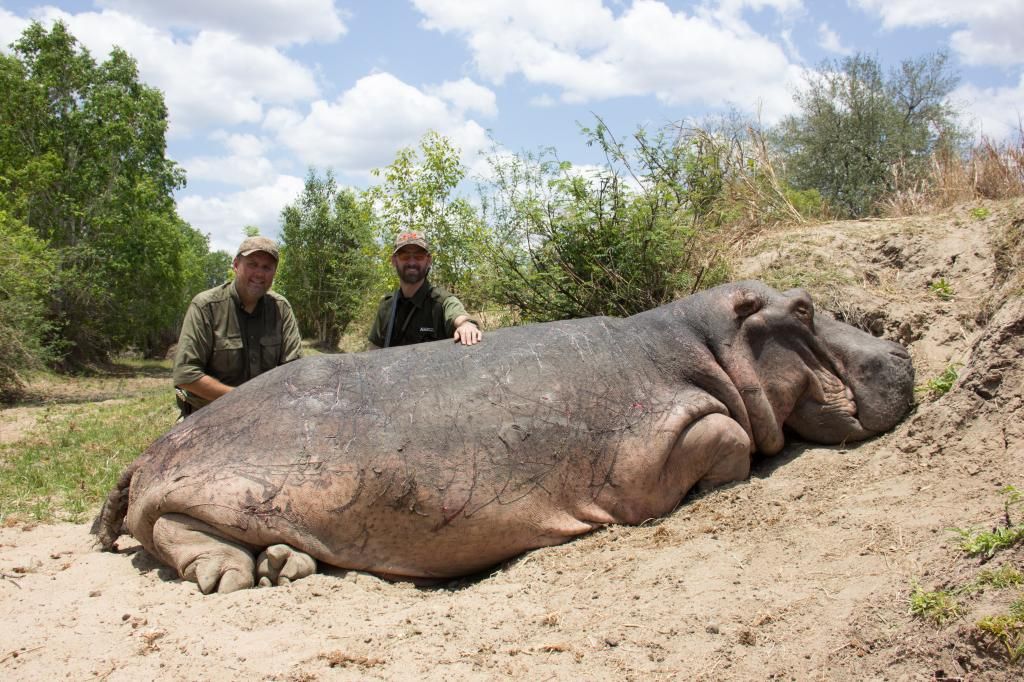 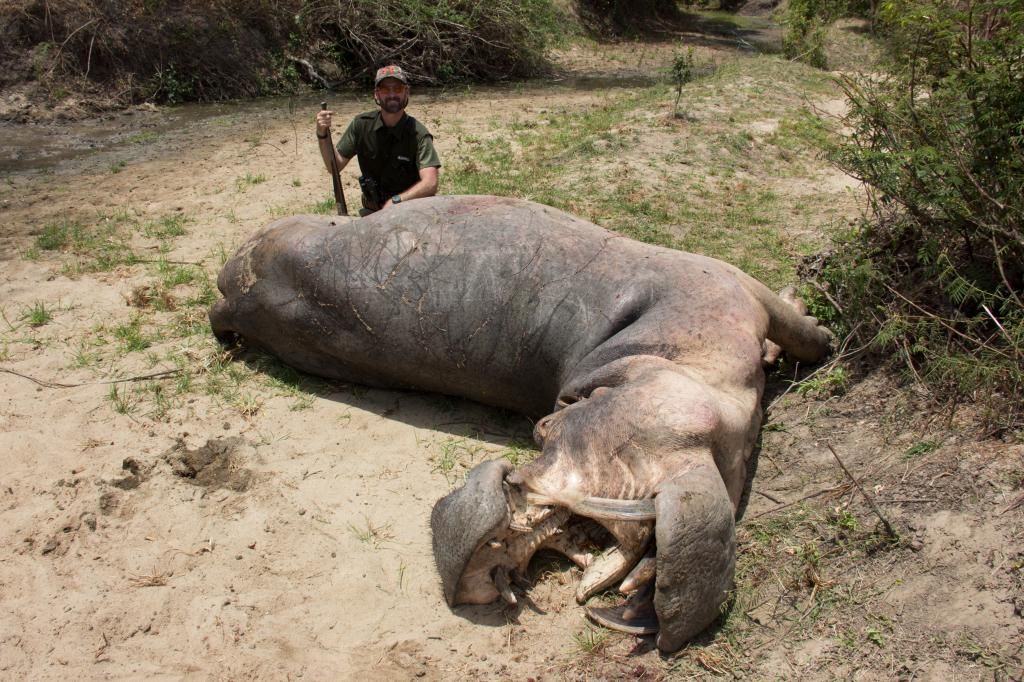 This Hippo was very large and is my best trophy of this trip. Although we did not measure the tusks (they did not come out of the skull while I was still there) there were exceptionally thick and long. The hide was extremely scarred and he had several open wounds. It was obvious that he had only recently been evicted from a pod by another male. I was very lucky to take an old guy like this and gain a fantastic trophy. It was a great experience and I was overjoyed to have had the chance to hunt him on dry ground with a double. We were fortunate that he ran away from us instead of toward us, or I would have been forced to brain him and Mike would almost certainly have had to back me up to ensure we didn’t get run over. We hunted Dave’s Hippo the same way a few days later. Again, coming around a bend in a mostly dry riverbed we came across a bend where some shallow water had collected. There were three Hippos in that water, and one was clearly a bull. Dave, Mike and I formed a skirmish line in the sand and advanced forward on our knees. Dave took the right hand side, with Mike in the middle and me on the left with the double. We advanced to about 15-20 yards. Dave got as comfortable as you can get shooting from your knees and attempted a shot at the Hippo’s earhole with his Winchester Model 70 in .375H&H. The Hippo surged forward in the water and went down, only his back poking above the surface as the other two bolted for a back exit we weren’t sure even existed. For the third time we had avoided inbound Hippo in a situation we thought was 50/50 for Hippos coming at us. Dave had actually hit just a little back but had broken the bull’s neck. He flopped forward and was finished. We then faced the daunting task of getting the massive animal out of the riverbed and into a place where we could get good photos and turn him into bait. The trackers started by cutting a road through the thick brush on the riverbank to bring the truck up to the bank. Next we sent our head tracker Frank into the water to secure a rope around the Hippo, which we then attached to the truck’s winch. We thought we would just winch him out of the water and then get our photos down in the riverbed before hoisting out major pieces of the Hippo. We were able to pull the entire Hippo up on the bank using the vehicle, however. Hippos make 5 baits each – each leg plus the neck. So between our two Hippos we were able to hang 10 lion/leopard baits. Buffalo I love hunting Cape Buffalo – it’s the one species I never seem to grow tired of. I’ve killed several and been in on the hunt for several more, but Dave had never hunted Cape Buffalo, so I wanted him to have the first opportunity. Early in the hunt we found the tracks of three dagga boys crossing the road in an area near the main camp. Mike said that he had seen these Buffalo a few times in the previous couple of weeks and that at least one of them was a good trophy. We took the tracks, Dave with his Winchester Model 70 in .375 H&H, Mike with the Greener .577 and me with the Merkel .450-400. We tracked for about 45 minutes before the Buffalo headed into a thicket, presumably to lie down as midday approached. We circled the thicket to the other side to confirm that no tracks came out. Mike decided that we would stand on the opposite side of the thicket while he sent the trackers through to push the Buffalo out to us. After about 30 minutes the trackers emerged from the thicket. They told us that they had stalked right up to the Buffalo – three bulls – bedded in the thicket. They said that we could stalk in and get a shot from within the thicket. So we stalked in, trying to move quietly on the crunchy leaves. Eventually we got to that place where the PH and the trackers could clearly see Buffalo but the less experienced clients could only see black patches among dark spots in the dense foliage. Mike got Dave on the sticks and got Dave to more or less see the bull we were after, but it was still a dicey shot – it was hard to make out exactly where to aim at that black blob. At Dave’s shot, the three leapt to their feet and thundered off. We took the tracks and found consistent blood but not in significant quantity. Moreover, it seemed to be muscular blood. We weren’t 100% sure where this Buffalo was hit. After another 30 minutes or so we jumped him and Dave took another two shots at him, striking him in the hindquarter and grazing a front shoulder. This increased the blood trail and we were more confident as we closed on him a second time. This time he jumped as we approached and ran from our right to our left. Both Dave and Mike fired at him – and as he crossed my line of sight I let one go from the Merkel at him, but knew as soon as I pulled the trigger that I had failed to lead him and either hit a tree or shot behind him. We followed again, and the third time we caught him Dave put him down for good. For a few more days we struggled a little with Buffalo. We just weren’t finding tracks. Then we caught a herd out in the open in a broad vlei we called “the Serengeti” due to its openness and the abundance of plainsgame we always found there. We snuck up a deep korongo to close distance on the herd, spooking a pair of civets along the way. We came up on the lip of the korongo and started sorting the herd. Mike found a nice 40” plus bull and set the sticks. I got on the sticks and on what I believed was the correct bull – I can tell a bull from a cow, but making sure that I’m on a hard bossed 40” bull rather than a soft 38” bull isn’t something I’m capable of deciding on my own, at least, not under the press of time. While Mike and I tried to confirm that I was on the correct Buffalo, they began to exhibit signs of nervousness. Mike started calling to them. A Buffalo call, in my experience, either works perfectly or not at all. In this instance the herd ran when Mike started mooing at them, and the opportunity was lost. I was dejected at the failure to take a nice Buffalo, but it was still relatively early in the hunt. A day or so later we saw a lone bull cross the road in front of us an immediately got on his track. Within 10 minutes we had closed to shooting distance and I put a shot into the boiler room at around 80 yards. We tracked for a short distance and I put a finisher into him. 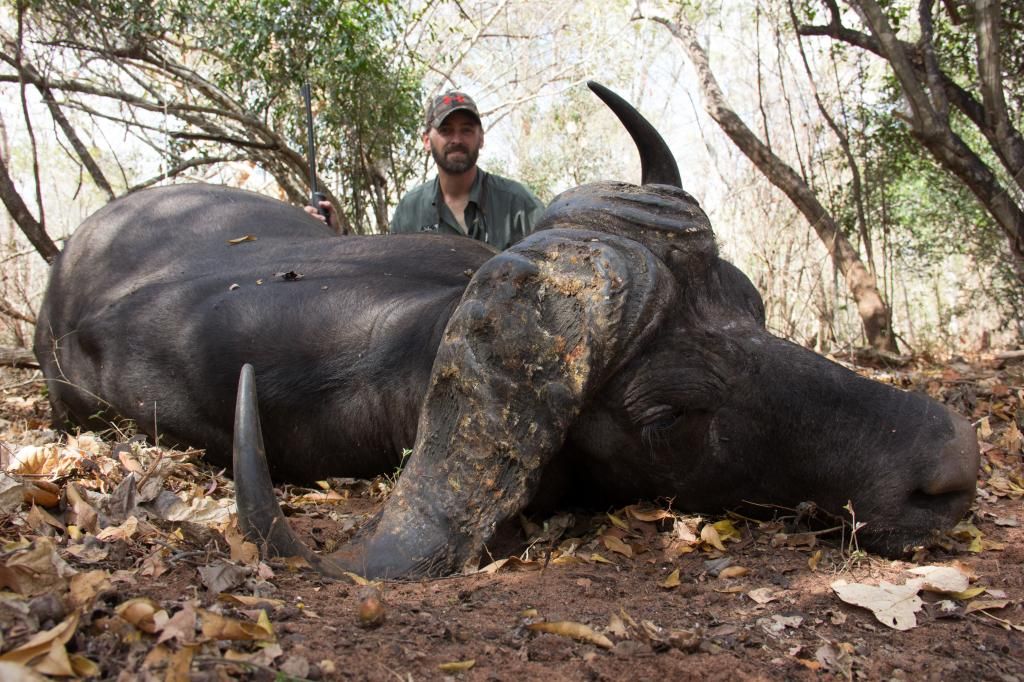 A few days after that I had what was the greatest day in my hunting career when we spotted 4 dagga boys crossing the road in pursuit of a large herd. We followed and caught up with the herd, which the bulls had now joined. Once again Mike tried his calling. This time the calling worked perfectly. The Buffalo turned and started coming toward us to investigate. Mike set the sticks for me and told me to just be ready for one of the bulls to come forward. After a few minutes, sure enough, here comes a big bull trotting down the left hand side of the herd to see what all the other Buffalo were so interested in. He came right to the front and looked right at me. Mike said “Take him.” So I put one dead center in his chest – he turned and ran, but not far, before keeling over. Surprisingly, the herd did not go very far. We stayed rooted to our spot and watched as other Buffalo tried in vain to help the one I’d shot back to his feet. Doug got great footage of the Buffalo trying to get their fallen colleague up – or maybe they were taking advantage of this opportunity to beat the crap out of the formerly dominant bull. Whatever it was, they stuck around to push the fallen bull around. Meanwhile Mike started calling again, and once again the herd began drifting toward us. Mike said “There’s an old guy near the back on the right, but he’s not very big.” “Let him walk,” I replied. I didn’t see the point in shooting a small Buffalo, even if it was an old one, when we didn’t really need the bait and I only had one Buffalo left on my license. “OK, let’s see if there’s anything else,” Mike said. He continued to call, and eventually another decent bull made his way to the front. “That’s a good Buffalo,” Mike said, “you should shoot him.” I lined up to take another frontal shot – a repeat of the shot on the first Buffalo, but just as I committed to the shot he began to turn to his left, my right. As the shot went off I thought I shot him behind the right shoulder on a severe “quartering to” angle. He ran off downhill to our right while the herd ran straight away from us uphill. The blood wasn’t great. It was consistent, but like Dave’s Buffalo, there wasn’t a lot of it. Eventually we tracked him to a thicket where tracks went in but did not come out. Mike said he wanted to give him 30 minutes before we moved in on him. “I’d rather he make the first move than us,” Mike said. Not five minutes later Mike said we were going in. Later he told us he changed his mind because he heard the Buffalo “wagging his tail” in there. We cautiously tiptoed into the thicket, ready and alert. Unfortunately, he saw, heard, or smelled us before we could locate him. All of a sudden there was a tremendous crashing as he came to his feet. We knew our wounded Buffalo was on the move but in the moment it was impossible to know whether he was coming or going. The trackers, taking no chances, scampered for trees. As it turns out, he was outbound, not inbound. Once again we tracked. After following him for a total of about a mile and a half, we jumped him in a patch of the Miombo forest. As he got to his feet Mike gave him a 750 grain Barnes X bullet from the .577 and a second later I let him have a North Fork Cup Point Solid from the Blaser. He went down and gave me the bellow I was looking for. 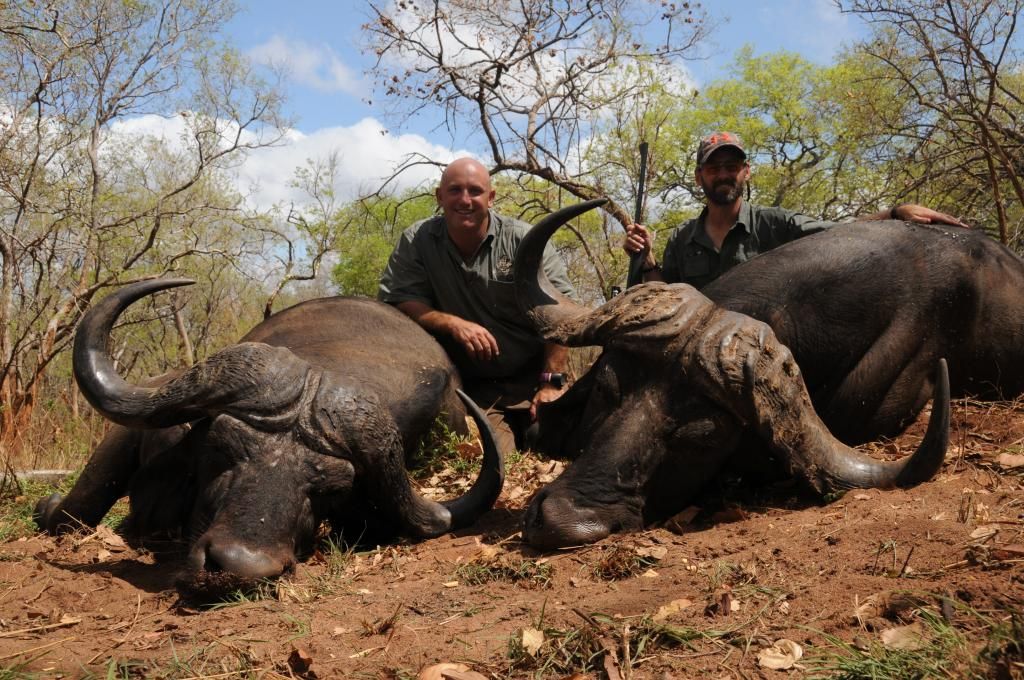 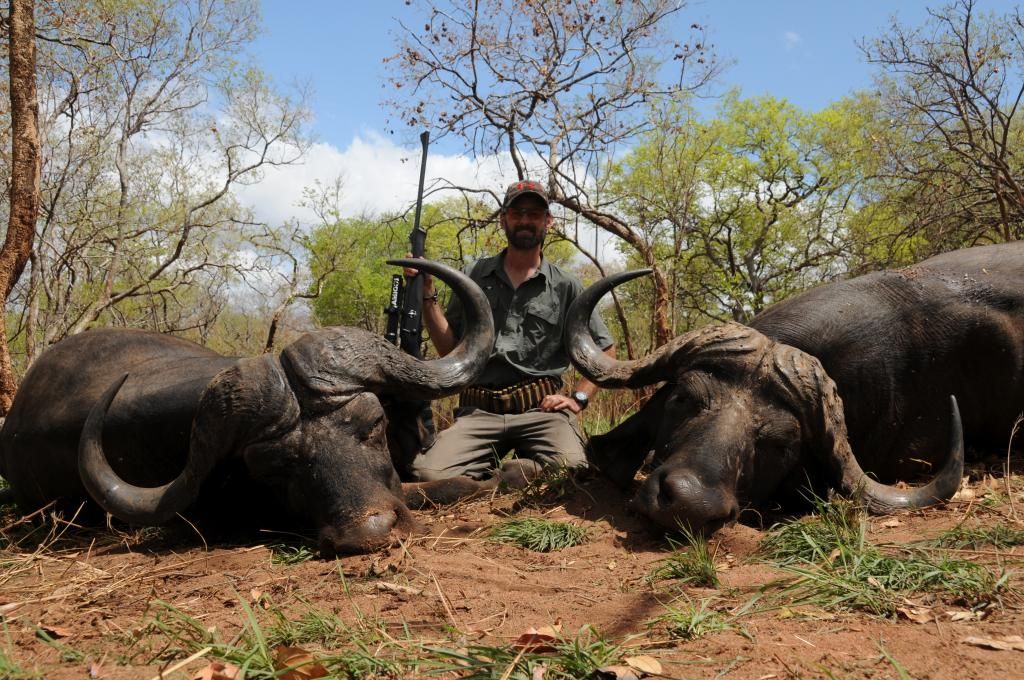 This was my first “double” on Buffalo. We had to drag the second Buffalo back to the first one to get the photos of them together. While we waited for the trackers to get the truck and bring it down to where the second Buff fell, I got stung by one of those African “killer” bees. Fortunately, I’m not allergic. Odds & Ends In addition to the plainsgame we shot, Dave and I both took Spotted Hyenas. There was certainly no shortage of them. I shot mine purely by chance – we were walking somewhere and the guys thought they saw the back of a Buffalo moving through the grass. It turned out to be a Hyena, and when he cleared the grass he was in and stood and looked at me, I shot him. He ran, and as he did, I hit him three more times in various places before he finally lay down. They only told me after I shot him about the trackers’ superstition that you shouldn’t shoot your Hyena before your cat – they consider it bad luck for the cat hunt. It wouldn’t have made a difference to me at the time, but now I wonder. . . . 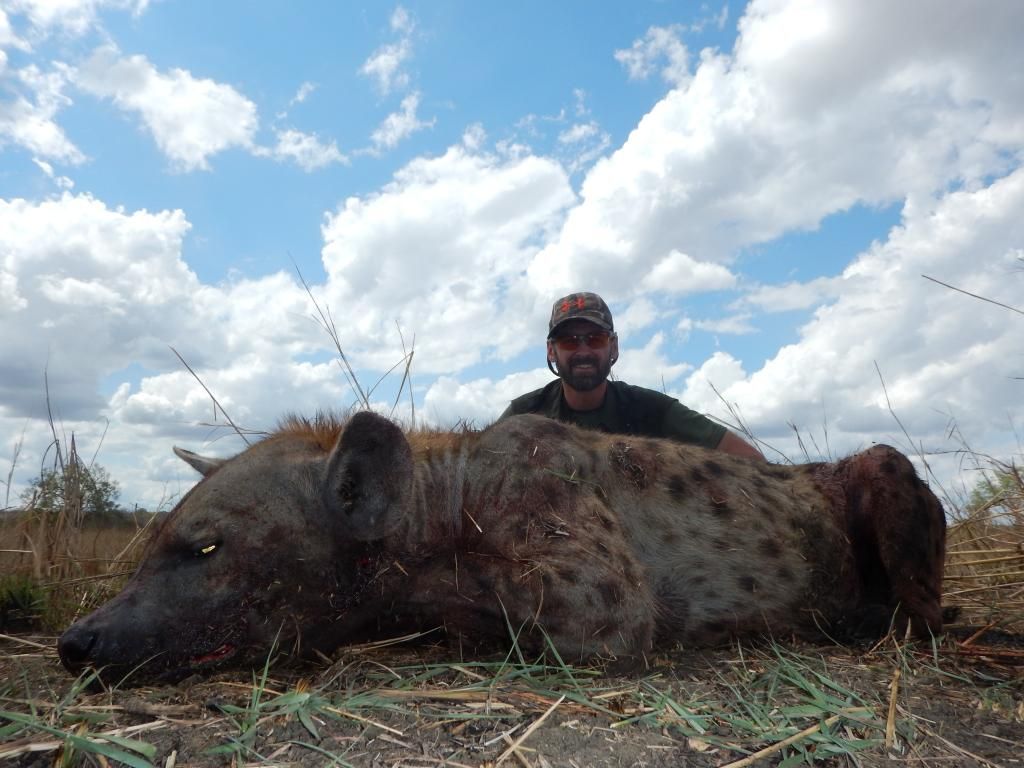 The Selous also has a subspecies of baboon called a “Yellow Baboon.” The Yellow Baboons do look different from the standard Chacma Baboons I’ve shot in other places. They do have much lighter colored fur – I can see why they call them “yellow” – and they seem to be generally smaller and longer limbed than other Baboons. The afternoon we were returning to Main Camp so that the truck could be taken into the village to be welded back together we came across a large troop in a wide river bottom and stopped to pick out a large male. I set up to ambush him as he walked out from behind a group of small trees and managed to smoke him.  Dave’s Leopard While the main focus of this hunt was a Lion, we were able to hang “combination” baits that would attract both Leopard and Lion. Dave was interested in Leopard – it was his priority species. While this block of the Selous does not generally produce really big Leopards, it produces a lot of them. We had many Leopards hit our baits, and no shortage of toms on our game cameras. In fact, as I indicate below, as my hunt wound down we had a very nice tom on my lion bait. Dave shot his Leopard the morning of Day 10 of the hunt after sitting a few of the previous afternoons and mornings. The cat came to the tree in full daylight and did not hesitate to move into position. While Dave was getting settled for the shot, the cat uncharacteristically lost his balance and actually fell off the branch, saving himself with his front paws but dangling precariously. He pulled himself back up and looked around as if to confirm no one saw that. Not only was it witnessed, it was filmed! Once the cat was back in position, Dave gently pulled the trigger, hitting him perfectly. He banged his chin on the branch on the way down and didn’t go anywhere. No Lion for Tom After Dave and I split up on Day 5, my days were filled with driving from bait to bait, endlessly checking trail cameras and shooting more bait along the way. The pressure for fresh bait was relentless. “I might ask you to shoot another Zebra,” Mike would say. After I had already shot both of my Hartebeest, a Zebra, a Waterbuck, both of my Wildebeeste, three Buffalo, and a Hippo, I didn’t have a lot left on license. We worked hard for Kudu, missing a very nice one at about 100 yards when I struck a tree dead center that I thought I was clear of. There are a lot of trees in this area and you rarely get a completely clear shot. We were also keen to find a nice Eland, but it just never happened for us. | ||
|
| One of Us |
Although we had male Lions on cameras starting early in the hunt, none were sufficiently mature to be shooters. 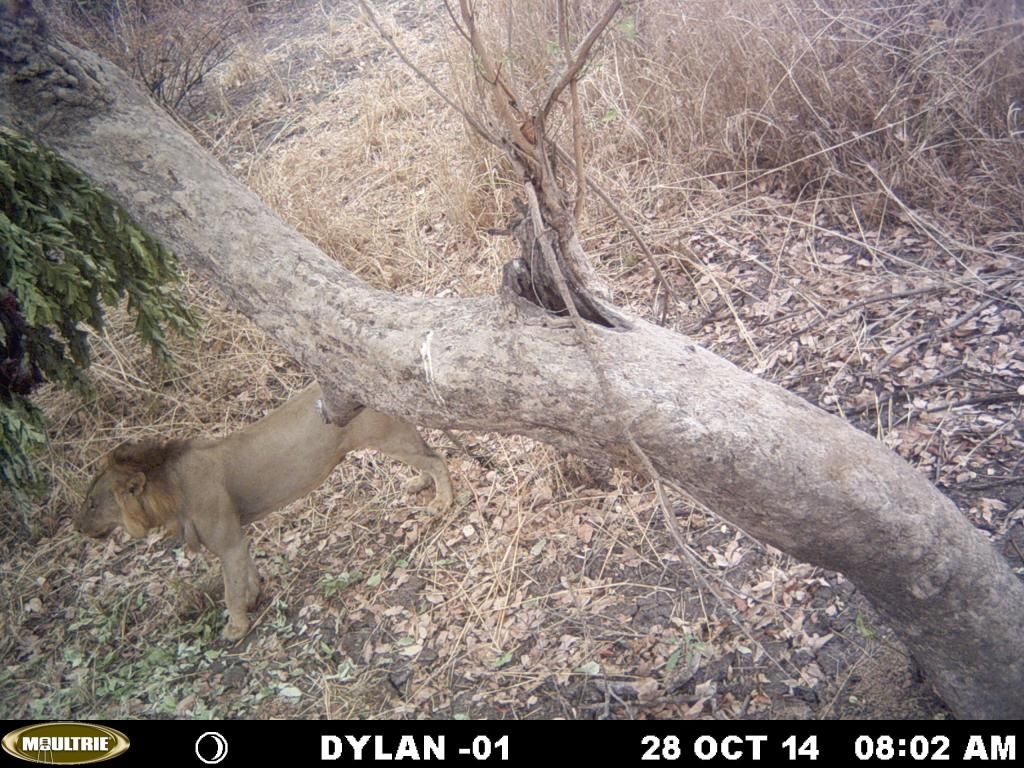  We did manage to get several very frustrating photos of this cat, but he was an expert at keeping his head and mane out of the frame, and there wasn’t enough for us to go on from these pictures to determine whether we should invest time building a blind and sitting. 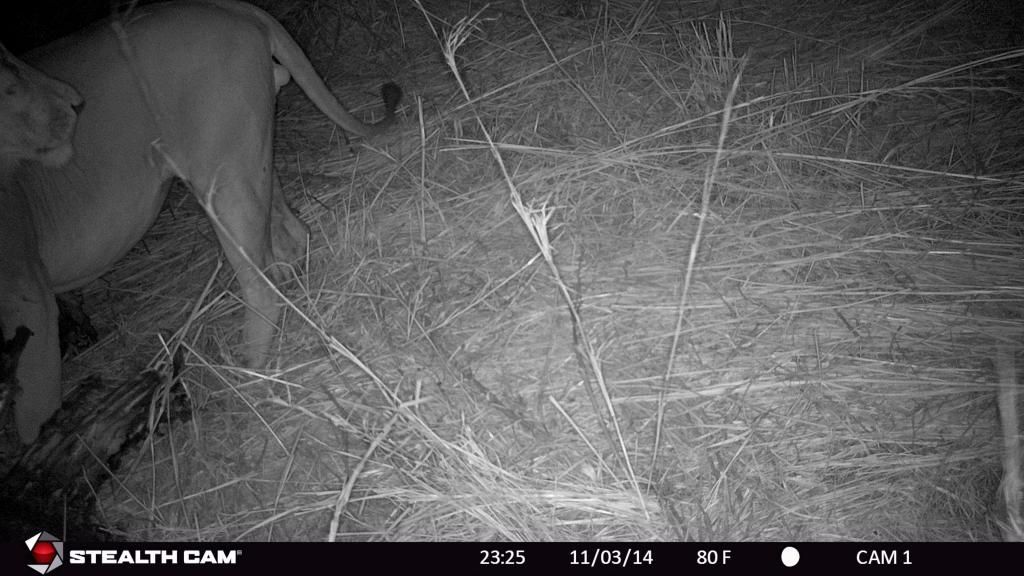  We found large tracks in several locations, however.    It was apparent that there were at least two, and possibly three, large male Lions who were working a mostly dry riverbed. But which direction they were headed, and where they were exactly, wasn’t clear. They weren’t hitting our baits, and we had no photos of them on our trail cameras. So we employed a two-prong approach to try to isolate them. First, we hung baits both upriver and downriver from places we found good tracks, trying to contain the Lions to those areas regardless of which direction they were headed. Second, we slept near the areas where we found fresh sign, and listened carefully in the night for roaring, then tried to pinpoint both direction and distance from where we were sleeping to where they were roaring, then focused on hanging bait near where we thought we had heard them. On the 14th day of our 16 day hunt, we built a blind at our most promising bait – we had no photos, but there were plenty of tracks and the bait had clearly been hit. We sat that afternoon but nothing came to the bait. Mike decided he wanted to move a bait from one location on the river to another. He said he’d drop me at our campsite for the evening so that I could check the temperature of the beer while he and one of the trackers moved the bait. When Mike showed up at our campsite about 45 minutes later he was visibly excited. He said that as they approached the site where they were moving the bait they caught sight of the lions – there were two males, one black-maned, the other blonde. Based on his fleeting glimpse in the moonlight, Mike thought they were both likely old enough and solid enough trophies, though he needed a better look at them in daylight. He was convinced they would hit the bait he had placed right where he had seen them. That night we listened intently but heard no roaring. Mike’s plan was to sit in our blind until the sun came up. If nothing came in, we would stalk in to the bait where he had seen the Lions the previous night and conceal ourselves below the line of a small korongo that fed into the riverbed near the bait site. We were up well before dawn and in the blind. Just before the sun came up, Doug whispered “something’s coming.” Sure enough, moments later a shadow moved in the brush in the riverbed. Through my riflescope I was able to identify it as a Hyena. Suddenly from the brush on the bank another shadow emerged, and with a muted yelp the Hyena took off. Now the second shadow resolved into the shape of a Leopard – and not a bad one at that. The Leopard lay down near the bait, and as the sun came up we studied him. It was a tom, and it was now the morning of Day 15 – the second to the last day of the hunt. Mike said: “That’s a pretty good Leopard.” I heard: “You should shoot that Leopard because it’s the second to the last day and the Lions obviously aren’t coming to this bait.” But I wasn’t there for Leopard, and even though I generally adhere to the philosophy that you don’t turn down opportunity, I wasn’t going to end my Lion hunt by shooting a Leopard. There was also an issue of uncertainty about what it might cost. I had paid for Lion hunt, and Mike said if I shot a Leopard I’d probably owe an additional amount over and above a trophy fee for the Leopard – possibly the difference in price between a “Lion/Buffalo” hunt and a “Full Bag” hunt. I told Mike I’d sit for the Leopard and shoot it if we killed the Lion first. And assuming I understood what killing a Leopard might cost me and it was an acceptable price. So we left the blind and drove toward the bait where Mike had seen the Lions the previous evening. We stopped the truck a kilometer and a half or so away from the bait site and approached quietly, moving slowly down the korongo to a point prior to its joining the riverbed. Peeking over the edge we could see our bait – but no Lions. Worse, there was no sign the Lions had visited the bait the previous night after Mike had seen them. We had planned to sit in the blind that afternoon but got busy moving baits around and ran out of time. So we got back in the blind the following morning – the last morning of the hunt. No Lions. But our friend the Leopard was back. Once again I declined to shoot him. Though it was the last day of the hunt Mike still wanted to freshen our bait. He was convinced the Lion would hit the bait where he had seen them the previous night if we could offer them something fresh. Fate once again smiled on me – our game scout spotted a lone Nyasa Wildebeeste feeding in some medium grass. With the wind in our favor we were able to approach to about 80 yards without his knowledge. I hit him well but he ran fairly hard. As he ran I lined up on his departing backside and let another one go but knew I’d shot behind him and called my miss immediately. As we started our follow up, Doug suggested that we may be walking up on a dead Hartebeest –there had been a pair of Hartebeest behind the Wildebeest as he ran off that I had not seen. My tunnel vision had focused on putting a second shot into the wounded Wildebeest and tuned out what was behind him – a novice error. I hoped Doug was wrong – I’d already shot two Hartebeest and that’s all I was allowed. Fortunately, he was. We spotted the two Hartebeest running – unwounded. Watching the video later you can see the Hartebeest turn and run straight away from us just before I shot at the running Wildebeest. And after we caught up to the Wildebeest and put him down for good, we learned that my second shot had in fact hit him in the rear leg. We hung the Wildebeeste early that afternoon and by 3:30 were in the blind, now down the river at the bait site where Mike had actually seen the lion. But after 2½ hours, nothing had moved in the riverbed or at the bait. I was frustrated. It was the last day. We were scheduled to depart on a charter the following day at noon and my gear in main camp (where I had not slept in days) was in a shambles. I had to sort out the Blue Bags (which were mainly filled with donations but also held some additional supplies, including one of my trail cameras and some other gear). Doug had to shoot interviews for the video. We needed to do media management so that everyone’s photos and the video from three video cameras and five or six still cameras could be compiled on a single drive and then duplicated to a drive I would take out with me. And of course I’d want to shower and change – particularly after that time in the bush without any shower or change of clothes – before getting on the plane and heading off for two days of travel home. All of that required some time in main camp. Mike wanted to sit again the following morning – Day 17 of a 16 days hunt and the morning of our departure. The problem was, we were 2½ hours from main camp, which was another ½ hour from the airstrip, and we still had a lot to do in main camp before the noon flight. I told Mike I was inclined to pull the cameras and the blind and just head back to main camp. We didn’t even have any indication that the lions were still in the area or any evidence that they’d be back on our bait in the morning. As the sun began to go down, a form emerged from the brush and headed toward our bait. My first thought – which I expressed out loud – was “Lioness.” Mike certainly perked up. But a second later I said “It’s that same damn Leopard.” Mike concurred. The cat we had seen on our bait upriver had moved downriver to this bait. Now I was sorely tempted. A nice tom Leopard, in the last hour of the last day of the hunt, and he had presented himself twice, on two different baits. It was like it was meant to be. But I held back. That’s not what I was here for. And just as the light faded and we were getting ready to leave, we heard a Lion roar down the river. Mike was convinced the Lions were coming to the bait where we had our blind set up. But it was now dark and too late to continue hunting that day. I reluctantly made the decision that we needed to pull the cameras and blind and return to main camp. As hard as it was, my decision to call it over when it was over was the right decision and I don’t regret it. We had a few quiet cocktails that night around the fire. It was not a celebratory atmosphere, unfortunately. The next day I slept until 8:00 a.m. At 8:00 I started getting everything done that needed to be done before we could depart for the airstrip at 11:30. There’s a lot to do before you depart, especially if you haven’t been in the main camp in days and you’re trying to put together a video of the trip. Among other things I needed to sort out all the tips and see each member of the staff to thank them. We got it all done, but it was tight. We made the charter and started the long slog home. A few days after I got home I came down sick. I’d anticipated this – following their July hunt in the Selous, everyone got sick. The PH and cameraman, Spike and Doug, both came down with Malaria. Ron was also down in the mouth for a number of days after returning. He guessed it was just accumulated exhaustion and nothing more. So I wasn’t surprised when I lost all power for a few days and just slept and scratched my tsetse fly and tick bites. I’m recovered now, and have mixed emotions about my experience in Tanzania. In the end, I’m satisfied that I gave it all I could. Mike worked as hard as he possibly could for me, and I have no criticism of any of his decisions. He’s an experienced and savvy Lion hunter. Sometimes it works out, and sometimes it doesn’t. “That’s hunting,” as they say. If all I wanted was a lion “trophy” I could have gone to South Africa on a “guaranteed hunt” and collected a trophy. That’s not what I wanted. I wanted to hunt Lion, and that’s what I did. Still. It was a big investment of money, time, and emotion. I have experience as my reward, but not a Lion trophy. So now I’ll return to continue my quest. My hunt isn’t over, merely interrupted. Whether we can continue to legally hunt or import African Lion trophies in the future remains to be seen. But I try not to be anxious about it – I’ll go back when I have time and can afford it, and I’ll finish what I started. After I returned, we got the final bill for the hunt and there was a misunderstanding about what we were paying for Dave’s Leopard. The misunderstanding isn’t really the “fault” of anyone – it’s just one of those things that all involved should have been clearer about and simply weren’t. Adam charged us for the difference between a “companion” hunt and a full “Leopard/Buff” hunt. I argued that we had understood that by paying for a second vehicle and second PH that’s essentially what we had already done. He agreed to give me a credit for what I paid for the second vehicle and PH, but still insisted that I owed for the difference between the “companion” hunt and the full “Leopard/Buff” hunt less what I had paid for the bait car and the second PH. I’m a little sore about it – the amount in controversy is $14,000 – but I can’t really fault Adam too much. We all could have been clearer about what we were paying. Adam treated me well when my mother in law passed and the hunt needed to be rescheduled. He didn’t oversell the opportunity to kill a lion. My experience with him suggests that he is honest and straightforward. But I learned a lesson I already knew – be 100% clear about your agreement, have it in writing, and confirm that your understanding about everything is consistent with the outfitter’s understanding. | |||
|
| One of Us |
Proper. | |||
|
| One of Us |
Great report and some very nice trophies. Too bad about the lion but that gives you a reason to go back!!! | |||
|
| One of Us |
Thank you for taking the time to put together an in depth report. You did not mention elephant other than the King of Spain used to hunt them there. Did you see any or have they all been poached? | |||
|
| One of Us |
That was a great report, I'm sorry you didn't get the lion but thanks for sharing! lets make a plan | |||
|
| one of us |
Great report, thanks for posting it. Frank "I don't know what there is about buffalo that frightens me so.....He looks like he hates you personally. He looks like you owe him money." - Robert Ruark, Horn of the Hunter, 1953 NRA Life, SAF Life, CRPA Life, DRSS lite | |||
|
| one of us |
BuffNut, Lion hunting to me is the hardest of all the African hunts. It gets to you mentally and that is far more exhausting than tracking elephant and buffalo for miles. Cats unless you are very lucky are just plain work and you being in the Selous late season made it even harder. Catch your breath, collect your coins and do it again as a big lion in my estimation is the greatest trophy of all. There is no experience quite like it. Seeing all your work come to together when the right lion comes to the bait is unmatched in the world of hunting. Great report and nice pix. Mark MARK H. YOUNG MARK'S EXCLUSIVE ADVENTURES 7094 Oakleigh Dr. Las Vegas, NV 89110 Office 702-848-1693 Cell, Whats App, Signal 307-250-1156 PREFERRED E-mail markttc@msn.com Website: myexclusiveadventures.com Skype: markhyhunter Check us out on https://www.facebook.com/pages...ures/627027353990716 | |||
|
| One of Us |
Great report and pictures. Mike | |||
|
| One of Us |
Lots of evidence of poaching in this area. We even got a picture of a poacher on one of our game cameras: 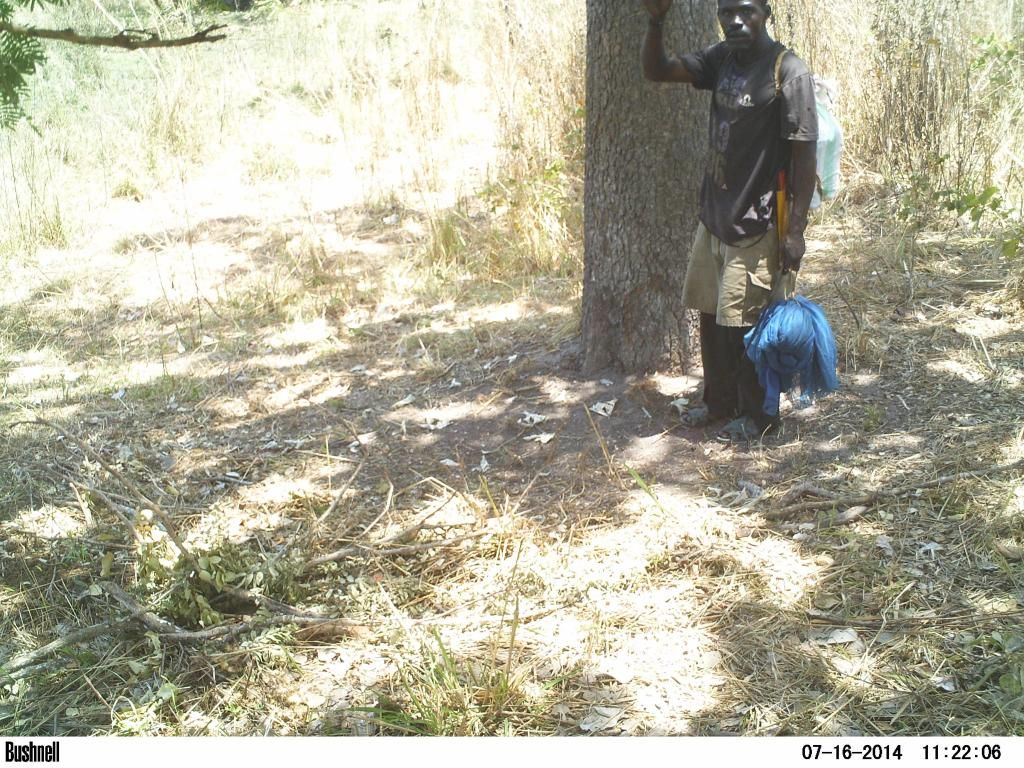 This guy had clearly never seen a game camera before and didn't know what it was or he would have taken it or destroyed it. Our game scout showed the picture around camp and was pretty sure he knew who this guy was. I asked if he would be arrested. Apparently there is a different kind of justice administered by the authorities in that part of the world. In any event, lots of evidence of poaching. We found elephant carcasses or bones most days. We found two poachers' camps, one of which had been used recently - there were fresh empty food cans and cigarettes in it. We did see elephant just about every day, though, including one very long (but thin) bull. If we were hunting elephant we would have taken a closer look at him. The elephant were VERY spooky as you would expect in an area with heavy poaching. We were charged by a cow one day while we were driving down the road - she ran at the car and trumpeted. Clearly the elephants were not as happy to see us as we were to see them. | |||
|
| One of Us |
Great report, I like Adams PH´s and would love to hunt with both Fell and Van Blerk one of these days. You get him next time. Anton | |||
|
one of us |
Extremely well produced report. "There are worse memorials to a life well-lived than a pair of elephant tusks." Robert Ruark | |||
|
| One of Us |
Well done report! Been there, done that with Lion hunting- if anything when I started it was "easier" in they didn't have the 6 year rule then, but dumped in a lot of money before I got one. I think in general, they are the most spendy to hunt as you found out. Hopefully it stays open and you can get another crack at them! Thanks for the report! | |||
|
| One of Us |
Great trophies, photos, and report. Thx for sharing. | |||
|
| One of Us |
Buffnut, I really enjoyed your report and fully understand the frustrations of your Lion hunt. Mike is a great hardworking PH and you were in good hands. However late season is always tricky and baits are quickly wasted. If Zambia puts Lion back on quota then I would say this is your best chance in Africa for a big free ranging cat. You have gone through the frustrations of Lion hunting and when you do connect it makes it all the sweeter. ROYAL KAFUE LTD Email - kafueroyal@gmail.com Tel/Whatsapp (00260) 975315144 Instagram - kafueroyal | |||
|
| one of us |
Well done. Great report and pics! Best regards, D. Nelson | |||
|
| one of us |
Nice report. I agree with you just shooting a fenced in lion. You certainly have my respect. | |||
|
| one of us |
http://www.sciencedaily.com/re.../01/150130092923.htm why stripes on zebras ? Here are some answers ! Hunt and report - well done ! | |||
|
| one of us |
It is enjoyable reading the circumstances around the hunt to go along with the trophy photos and hunt details.Congratulations. | |||
|
| One of Us |
Awesome report - thanks for taking the time to add in all the details. Mike hunts hard and is a top PH! | |||
|
| One of Us |
Well done! Very nice report and pics. Hard luck on the lion but anyone that's hunted wild lion understands the drill. Mike Fell is a solid PH. I have shared some camps with Mike in Western Tanzania. He is the real deal. That 460 weatherby he carries is most likely the one Gerard Miller handed down to him. | |||
|
| one of us |
Great detail in that report and I like the fact you added the +'s and -'s. Too often folks are so enamored with the hunt or PH we don't get a clear picture of what went right and/or wrong. Well done. And some nice trophies despite the fact you didn't connect with your lion. As others have said, probably the toughest hunt out there as far as success today. On the plains of hesitation lie the bleached bones of ten thousand, who on the dawn of victory lay down their weary heads resting, and there resting, died. If you can talk with crowds and keep your virtue, Or walk with Kings - nor lose the common touch... Yours is the Earth and everything that's in it, And - which is more - you'll be a Man, my son! - Rudyard Kipling Life grows grim without senseless indulgence. | |||
|
| One of Us |
Sums it up very nicely. Excellent report and a hell of a hunt. | |||
|
| One of Us |
Excellent report; thanks! Scary problems with your Blaser though; hope you get it sorted. ---------------------------------------------------------------------------------------------------------------------------------- “A man can never have too much red wine, too many books, or too much ammunition” ― Rudyard Kipling | |||
|
| One of Us |
Thank you for a great report. Not only entertaining but useful. Hunting late season Selous is seriously like hard work. Hot as hell and it seems like you're always going up or downhill. You mentioned the poor lunches. On my last Selous hunt the outfitter didn't even have a chop box. Lunch was usually a sandwich on the run. Unfortunately, one of the bad things about hunting with first rate outfitters is that you get spoiled. To me, lunch is an enjoyable ritual--often with leftovers from the last night's dinner--but excellent. A quick bite just doesn't make it. Likewise, I don't do fly camps anymore. Too old for it and I enjoy a first rate main camp. It is too bad when outfitters cut corners on things that--in reality--cost very little. Good report. | |||
|
| One of Us |
Love the fly camping and the buffalo. Sounds like a proper safari | |||
|
One of Us |
Thanks for a great report! It sounds like a great safari and that was a spectacular hippo shot in a great way, good luck in your quest for a lion, I may humbly suggest the Zimbabwe conservancies for a best chance for a great lion. | |||
|
| One of Us |
Awesome! Congrats! Thanks for sharing with us | |||
|
| One of Us |
Great report nice photos better luck on the Lion next time | |||
|
| one of us |
I love fly camping. Seems like a real adventure. And fly camping in Africa is still heaps more comfortable than hunting in AK. | |||
|
| One of Us |
Wow - talk about a great hunt with some excellent trophies!! | |||
|
| Powered by Social Strata |
| Please Wait. Your request is being processed... |
|
 The Accurate Reloading Forums
The Accurate Reloading Forums  THE ACCURATE RELOADING.COM FORUMS
THE ACCURATE RELOADING.COM FORUMS  Hunting
Hunting  Hunting Reports - Africa
Hunting Reports - Africa  2014 Selous Buffalo, Hippo & Lion Hunt
2014 Selous Buffalo, Hippo & Lion Hunt

Visit our on-line store for AR Memorabilia

